Paul van Yperen's Blog, page 355
February 11, 2016
EFSP's Dazzling Dozen: Yé-yé!
Yé-yé was the Francophone take on teen pop that flourished in France during the early 1960s and briefly became a global phenomenon. The genre took its name from a bastardization of the English yeah yeah and gave the world some of the 1960s’ best pop songs. The yé-yé movement had its origins in the radio programme Salut les copains (hello pals), which was first aired in December 1959. The program became an immediate success and one of its sections, le chouchou de la semaine (this week's sweetheart) became the starting point for most yé-yé singers. Any song that was presented as a chouchou went straight to the top places in the charts. The yé-yé songs had innocent themes such as Françoise Hardy's Tous les garçons et les filles: All the guys and girls my age know how it feels to be happy, but I am lonely. When will I know how it feels to have someone? Although originating in France, the yé-yé movement extended over Western Europe. Here are twelve yé-yé stars who als starred in films.
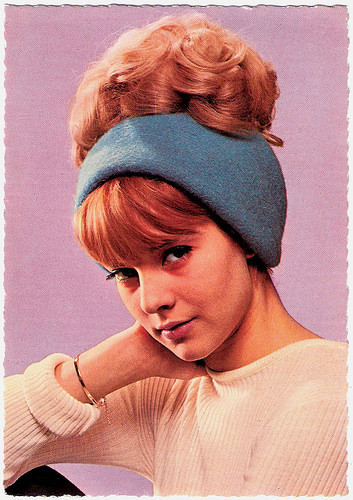
French postcard by E.D.U.G., no. 329. Photo: De Cordon / RCA Victor.
French pop singer Sylvie Vartan (1944) was one of the first rock girls in France. She was the diva of the yé-yé genre. With Johnny Hallyday she formed France's Golden Couple of their generation and they performed in several films, together and apart.
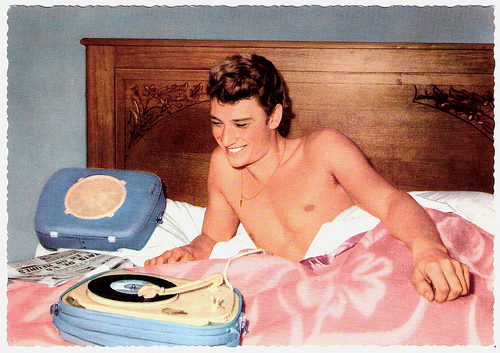
German postcard by Krüger, no. 902/307. Photo: Pierre Spitzer.
Flamboyant singer and actor Johnny Hallyday (1943) is the father of French rock and roll. He was a European teen idol in the 1960s with record-breaking crowds and mass hysteria, but he never became popular in the English-speaking market. In recent years he has concentrated on being an actor and appeared in more than 35 films.
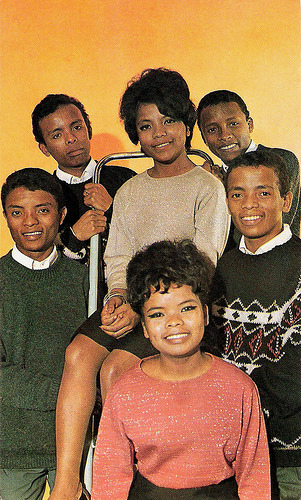
French postcard by E.D.U.G., no. 374. Photo: Lynx, Paris.
Les Surfs was a yé-yé-style pop group from Madagascar, that existed from 1963 until 1971.
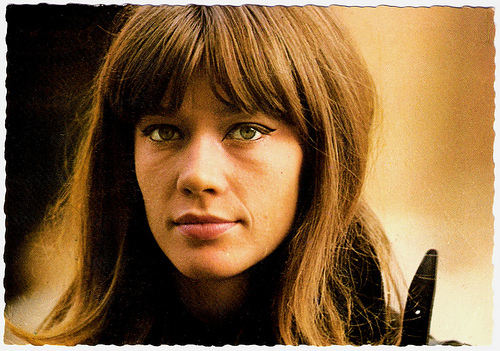
French postcard by Starcolor, Marseille, nr. 972. Photo: Jean-Marie Perier.
French singer, actress and astrologer Françoise Hardy (1944) was the original yé-yé girl of the sixties with her trademark jeans and leather jacket. She occasionally appeared in international films of the 1960s, and today she is still an iconic figure in fashion, music and style.
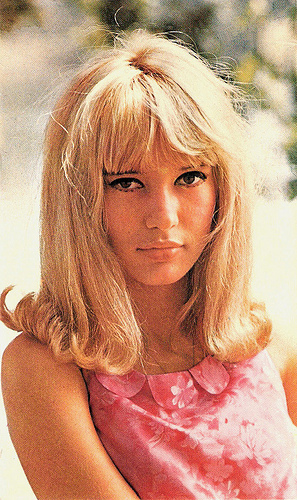
French postcard by PDG, no. 1205, presented by Corvisart, Epinal. Photo: Dalmas / Disc AZ.
In the 1960s, Beautiful blonde British starlet Gillian Hills (1944) rose to fame in France, where she a was a successful ye-ye singer and debuted in Roger Vadim’s Les Liaisons dangereuses (1959).
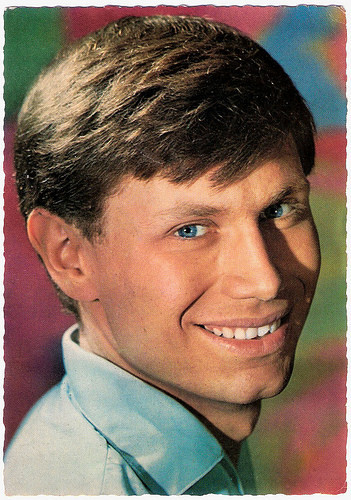
French postcard by Editions Starama, no. 868. Photo: Nisak / Vogue.
French singer and songwriter Michel Paje (1945) was one of the yéyé pop stars of the early 1960s. He worked for the cinema as an actor and composer and is now known as a voice actor under his real name Michel Roy.
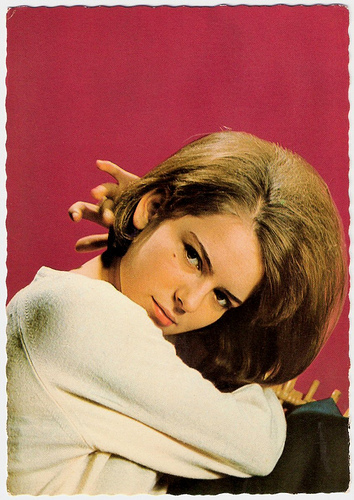
French postcard by PSG, no. 947. Photo: Aubert-Philips.
French France Gall (1947) rocketed to fame in the 1960s as a naive young singer performing songs written by Serge Gainsbourg. In 1965 she won the Eurovision Song Contest with his Poupée de cire, poupée de son. But, after meeting and marrying, French singer-songwriter Michel Berger, her career was completely turned around and she soon went on to make a name for herself as one of the top female artists on the French music scene.

French postcard by E.D.U.G., presented by Les Carbones Korès Carboplane, no. 351. Photo: Gérard Neuvecelle.
Handsome Swedish singer, actor and model Bob Asklöf (1942-2011) was a yé-yé idol in France during the early 1960s. He also worked as an actor for film, stage and TV and in the 1970s he appeared nude in several French erotic films.
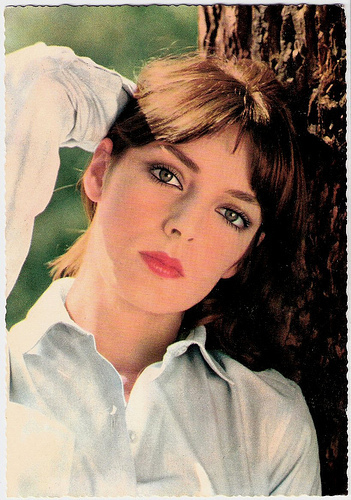
German postcard by Krüger, no. 902/344. Photo: Gérard Decaux.
Marie Laforêt (1939) is a French singer and actress of Armenian descent. After her first appearance in the drama Plein Soleil (René Clément, 1960) opposite Alain Delon she became very popular and interpreted many roles in the 1960s. As a singer she is best loved for Marie douceur, Marie colère, her version of the Rolling Stones hit Paint it black.
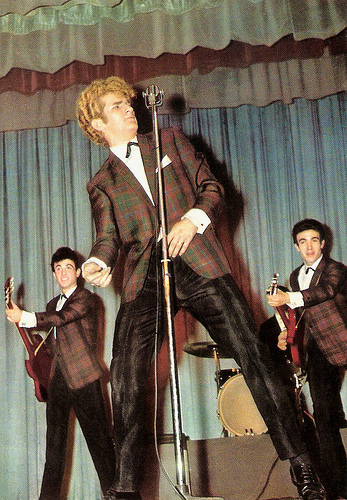
French postcard by Editions P.I., Paris, no. 1079. Photo: Noa.
French singer and actor Eddy Mitchell (1942) began his career in the late 1950s, with the rock & roll group Les Chaussettes Noires (The Black Socks). He went solo in 1963 and also played in a many films. In numerous black and white French musical comedies of the 1960s he appeared as himself fronting his band. His ‘real’ acting career started with Coup de torchon (1981). After a career of 50 years Mr. Eddy has become the tranquil daddy of French rock & roll.
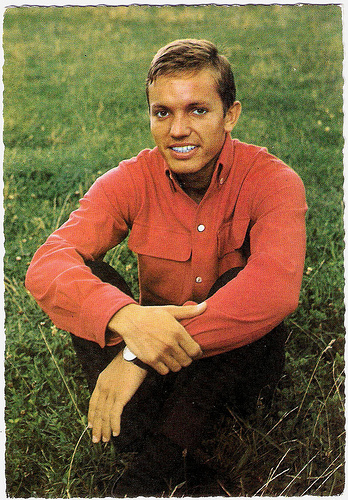
French postcard by E.D.U.G., no. 349. Photo: G. Neuvecelle / Barclay.
Jean-François Grandin, photographer and businessman, died in Paris on 11 October 2012. In the 1960s he was well known in France as the yé-yé singer Frank Alamo.
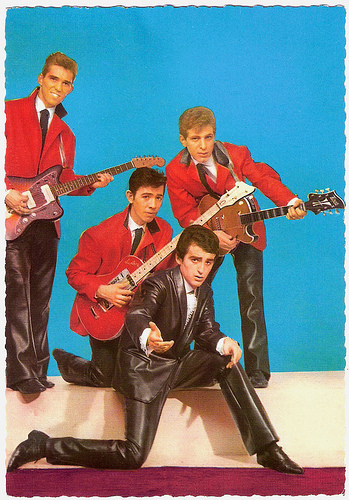
French postcard by E.D.U.G., no. 228. Photo: Sam Lévin.
Les Chats Sauvages (The Wild Cats) was a French rock and roll band, formed in 1961. Together with Les Chaussettes Noires, they were among the first outfits to perform rock and roll music in France. Les Chats Sauvages was originally composed of Dick Rivers (Hervé Forners) on vocals, John Rob (Jean-Claude Roboly) on guitar, James Fawler (Gérard Roboly) on guitar, Jack View (Gérard Jaquemus) on bass, and Willy Lewis (Wiliam Taïeb) on drums.
This is a post for Postcard Friendship Friday, hosted by Beth at the The Best Hearts are Crunchy. You can visit her by clicking on the button below.

Sources: Flavorwire and Wikipedia.

French postcard by E.D.U.G., no. 329. Photo: De Cordon / RCA Victor.
French pop singer Sylvie Vartan (1944) was one of the first rock girls in France. She was the diva of the yé-yé genre. With Johnny Hallyday she formed France's Golden Couple of their generation and they performed in several films, together and apart.

German postcard by Krüger, no. 902/307. Photo: Pierre Spitzer.
Flamboyant singer and actor Johnny Hallyday (1943) is the father of French rock and roll. He was a European teen idol in the 1960s with record-breaking crowds and mass hysteria, but he never became popular in the English-speaking market. In recent years he has concentrated on being an actor and appeared in more than 35 films.

French postcard by E.D.U.G., no. 374. Photo: Lynx, Paris.
Les Surfs was a yé-yé-style pop group from Madagascar, that existed from 1963 until 1971.

French postcard by Starcolor, Marseille, nr. 972. Photo: Jean-Marie Perier.
French singer, actress and astrologer Françoise Hardy (1944) was the original yé-yé girl of the sixties with her trademark jeans and leather jacket. She occasionally appeared in international films of the 1960s, and today she is still an iconic figure in fashion, music and style.

French postcard by PDG, no. 1205, presented by Corvisart, Epinal. Photo: Dalmas / Disc AZ.
In the 1960s, Beautiful blonde British starlet Gillian Hills (1944) rose to fame in France, where she a was a successful ye-ye singer and debuted in Roger Vadim’s Les Liaisons dangereuses (1959).

French postcard by Editions Starama, no. 868. Photo: Nisak / Vogue.
French singer and songwriter Michel Paje (1945) was one of the yéyé pop stars of the early 1960s. He worked for the cinema as an actor and composer and is now known as a voice actor under his real name Michel Roy.

French postcard by PSG, no. 947. Photo: Aubert-Philips.
French France Gall (1947) rocketed to fame in the 1960s as a naive young singer performing songs written by Serge Gainsbourg. In 1965 she won the Eurovision Song Contest with his Poupée de cire, poupée de son. But, after meeting and marrying, French singer-songwriter Michel Berger, her career was completely turned around and she soon went on to make a name for herself as one of the top female artists on the French music scene.

French postcard by E.D.U.G., presented by Les Carbones Korès Carboplane, no. 351. Photo: Gérard Neuvecelle.
Handsome Swedish singer, actor and model Bob Asklöf (1942-2011) was a yé-yé idol in France during the early 1960s. He also worked as an actor for film, stage and TV and in the 1970s he appeared nude in several French erotic films.

German postcard by Krüger, no. 902/344. Photo: Gérard Decaux.
Marie Laforêt (1939) is a French singer and actress of Armenian descent. After her first appearance in the drama Plein Soleil (René Clément, 1960) opposite Alain Delon she became very popular and interpreted many roles in the 1960s. As a singer she is best loved for Marie douceur, Marie colère, her version of the Rolling Stones hit Paint it black.

French postcard by Editions P.I., Paris, no. 1079. Photo: Noa.
French singer and actor Eddy Mitchell (1942) began his career in the late 1950s, with the rock & roll group Les Chaussettes Noires (The Black Socks). He went solo in 1963 and also played in a many films. In numerous black and white French musical comedies of the 1960s he appeared as himself fronting his band. His ‘real’ acting career started with Coup de torchon (1981). After a career of 50 years Mr. Eddy has become the tranquil daddy of French rock & roll.

French postcard by E.D.U.G., no. 349. Photo: G. Neuvecelle / Barclay.
Jean-François Grandin, photographer and businessman, died in Paris on 11 October 2012. In the 1960s he was well known in France as the yé-yé singer Frank Alamo.

French postcard by E.D.U.G., no. 228. Photo: Sam Lévin.
Les Chats Sauvages (The Wild Cats) was a French rock and roll band, formed in 1961. Together with Les Chaussettes Noires, they were among the first outfits to perform rock and roll music in France. Les Chats Sauvages was originally composed of Dick Rivers (Hervé Forners) on vocals, John Rob (Jean-Claude Roboly) on guitar, James Fawler (Gérard Roboly) on guitar, Jack View (Gérard Jaquemus) on bass, and Willy Lewis (Wiliam Taïeb) on drums.
This is a post for Postcard Friendship Friday, hosted by Beth at the The Best Hearts are Crunchy. You can visit her by clicking on the button below.

Sources: Flavorwire and Wikipedia.
Published on February 11, 2016 22:00
February 10, 2016
Ray Milland
British actor and director Ray Milland (1905-1986) had a screen career that ran from 1929 to 1985. He appeared in many Hollywood movies as the archetypal, unflappable British gentleman. Milland is best remembered for his gut-wrenching, Academy Award–winning portrayal of an alcoholic writer in The Lost Weekend (1945), the murder-plotting husband in Dial M for Murder (1954), and as The Man With the X-ray Eyes (1963).
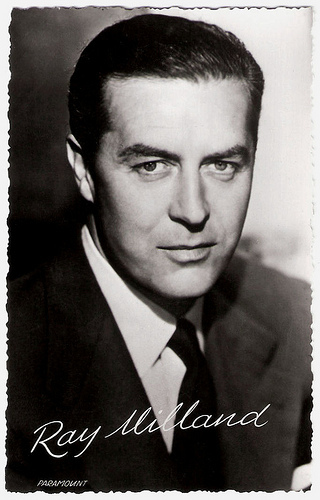
Dutch postcard by Takken, no. 3446. Photo: Paramount.
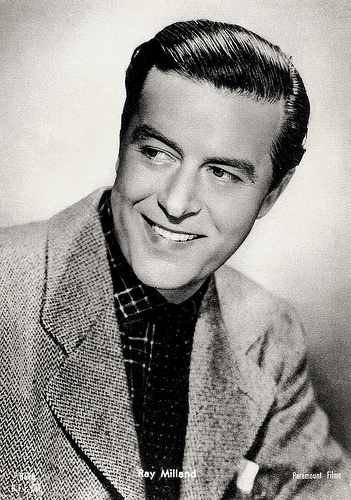
Italian postcard by Casa Editr. Ballerini & Fratini (B.F.F.), Firenze (Florence), no. 8618. Photo: Paramount Films.
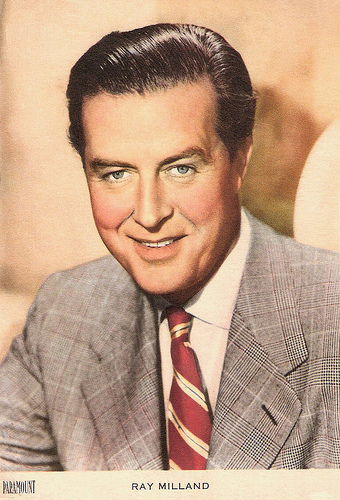
Argentinian postcard, no. 54. Photo: Paramount.
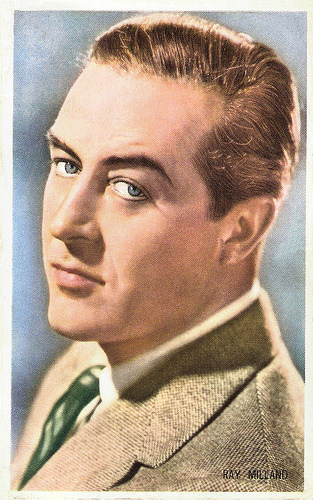
Belgian collectors card by Kwatta, Bois d'Haine, no. C 319. Photo: M.G.M. Publicity still for A Life of Her Own (George Cukor, 1950).
Discovered by a Hollywood Talent Scout
Ray Milland was born Reginald Alfred John Truscott-Jones on a mountain called Cymla, above the town of Neath in Wales in 1905. Milland was the son of Alfred Jones and Elizabeth Annie (née Truscott). As a child, he took the name of his stepfather, Mullane, and was known in his early career as Jack Mullane. He later took his stage name Raymond Milland from the flat area of land called the mill lands in Neath, which he remembered fondly from his youth.
In 1925, Milland enlisted as a guardsman with the Royal Household Cavalry in London. As part of his training, he became skilled in fencing, boxing, horsemanship and marksmanship. An expert shot, he became a member of his company's rifle team, winning many prestigious competitions, including the Bisley Match in England.
When his duty service was completed in 1928, Milland stumbled into acting when a British filmmaker spotted him at a party and offered the 22-year-old a bit part in the romance The Plaything (Castleton Knight, 1929). More small and big roles in the British cinema and on stage followed. Among his British films were the silent ‘backstage’ drama Piccadilly (Ewald André Dupont, 1929) starring Anna May Wong , the adventure The Flying Scotsman (Castleton Knight, 1929) and the drama The Informer (Arthur Robison, 1929).
Raymond Milland was discovered by a Hollywood talent scout while performing on the stage in London, and travelled to America under a short-term contract with MGM. MGM shortened his first name to Ray and continued casting the acting novice in minor supporting roles.
MGM agreed to loan him out for more substantial parts in Will Rogers' Ambassador Bill (Sam Taylor, 1931) at Fox in which he tries to overthrow the boy-king of a fictional European country, and Warner Bros.' Blonde Crazy (Roy Del Ruth, 1931) in which he competes with con-artist James Cagney for Joan Blondell's affections.
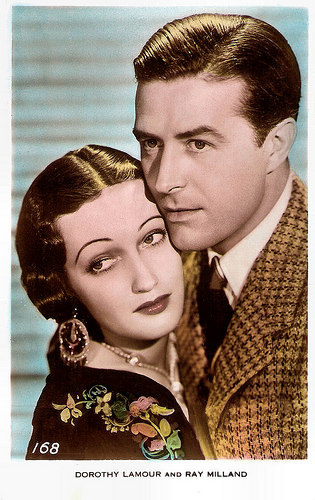
British postcard in the Art Photo series, no. 38-1. Photo: publicity still for Tropic Holiday (Theodore Reed, 1938) with Dorothy Lamour.
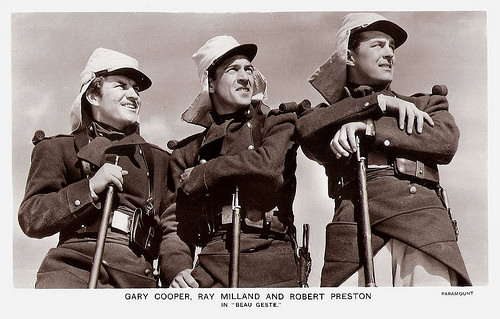
British postcard, London, no. FS 191. Photo: Paramount. Publicity still for Beau Geste (William A. Wellman, 1939) with Robert Preston and Gary Cooper.
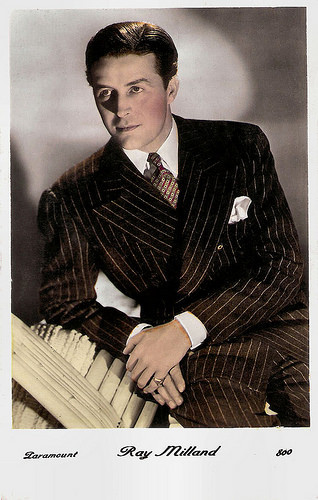
French postcard, no. 800. Photo: Paramount.
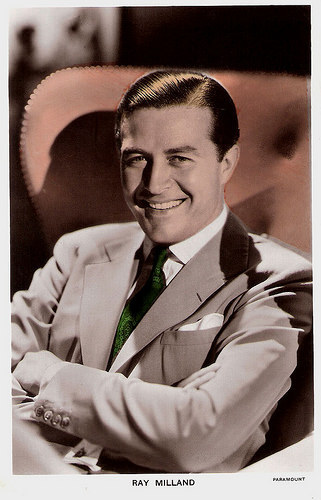
British postcard in the Caligraph Series, London, no. C 351. Photo: Paramount.
Long-term Contract at Paramount
When his contract with MGM expired, Ray Milland bounced around taking whatever roles he could get, including a supporting part in Fox's Charlie Chan in London (Eugene J. Forde, 1934). He returned to England for roles in This Is the Life (Albert de Courville, 1933) with Gordon Harker and the comedy Orders is Orders (Walter Forde, 1934), a satire on Hollywood movie-making.
Finally, based on the strength of two films he made with Carole Lombard - Bolero (Wesley Ruggles, 1934) and We’re Not Dressing (Norman Taurog, 1934) - as well as the endorsement of his leading lady, Paramount Pictures signed Milland to a long-term contract. He would remain with the studio for some twenty years.
Charming and debonair, he can be seen as suave, self-assured romantic leading man in a number of excellent drawing-room comedies, mysteries and adventures, including The Big Broadcast of 1937 (Mitchell Leisen, 1936), The Jungle Princess (William Thiele, 1936) featuring Dorothy Lamour, Beau Geste (William Wellman, 1939) with Gary Cooper, and I Wanted Wings (Mitchell Leisen, 1941) with Veronica Lake.
At Film Reference , Frank Thompson writes: “The quintessential Milland performances of the ‘leading man’ variety are contained in Leisen's delightful Easy Living and Kitty. The darker, more sinister side of his personality first came to the fore in Farrow's Alias Nick Beal, a film in which Milland plays the Devil himself.”
Easy Living (Mitchell Leisen, 1937) was a depression-era screwball comedy and social satire written by Preston Sturges and starring Jean Arthur. Reel Classics calls it “an often-overlooked delight”. Kitty (1945, Mitchell Leisen) was a variation on Pygmalion, in which a London aristocrat (Milland) takes it upon himself to make a lady of a guttersnipe (Paulette Goddard).
Milland had a terrible accident during the filming of Hotel Imperial (Henry Hathaway, 1939) with Isa Miranda , when, taking his horse over a jump, the saddle-girth broke and he landed head-first on a pile of bricks. His most serious injuries were a concussion that left him unconscious for 24 hours, a 3-inch gash in his skull that took 9 stitches to close, and numerous fractures and lacerations on his left hand.
When the Second World War began, Milland tried to enlist in the U.S. Army Air Forces, but was rejected because of his impaired left hand. He worked as a civilian flight instructor for the Army, and toured with a United Service Organisation (USO) South Pacific troupe in 1944.
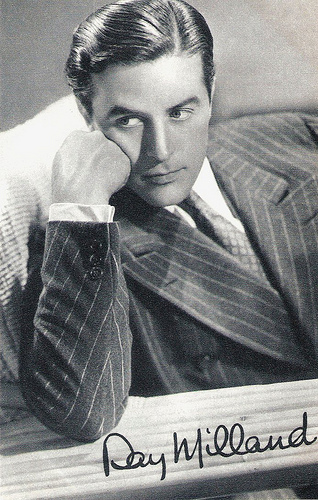
British postcard by Real Photogravure.
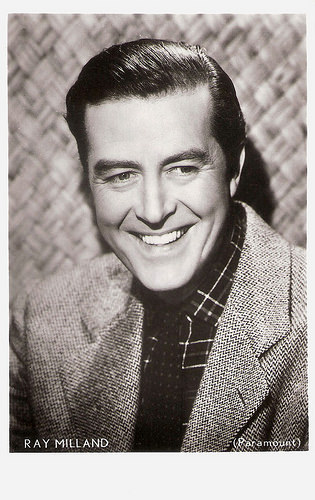
Dutch postcard. Photo: Paramount.
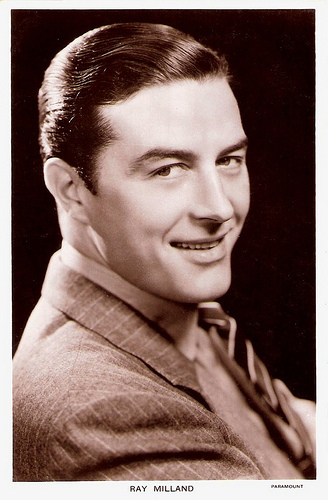
British postcard in the Picturegoer Series, London, no. 991b. Photo: Paramount.
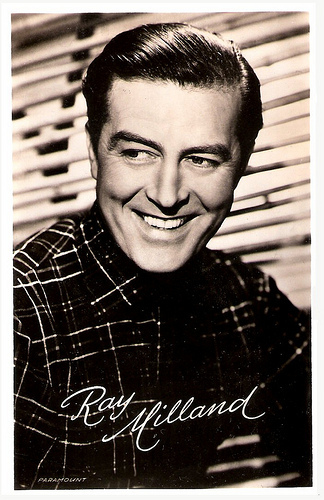
Dutch postcard. Photo: Paramount.
An Alcoholic Trying To Kick the Booze
Ray Milland had made over 60 feature films by the time he won an Oscar for his portrayal of an alcoholic trying to kick the booze in Billy Wilder's The Lost Weekend (1945). It would be pinnacle of Ray Milland's career and an acknowledgement of his serious dramatic abilities. The surprise shown by the critical establishment at Milland's proficiency in the role suggests that nothing much had ever been expected of him.
Milland was the first Welsh actor to ever win an Oscar. He was also the first actor not to have spoken a single word during his acceptance speech, preferring to simply bow his appreciation before casually walking to the stage exit. For this performance, he was also given an award at the first Cannes Film Festival.
Five years later, he gave a strong performance in Close to My Heart (William Keighley, 1951), starring with Gene Tierney as a couple trying to adopt a child. As Milland grew older and his value as a romantic lead began to wane, the more sinister aspects of this self-assuredness became more evident.
In 1954, he starred as the suave and mannerly accomplice opposite Grace Kelly in Dial M for Murder (Alfred Hitchcock, 1954). Other films that exploited the murderous glint in Milland's eloquent eyes include The Thief (Russel Rouse, 1951) a Film Noir without any dialogue, and The Girl in the Red Velvet Swing (Richard Fleischer, 1955) with Joan Collins .
He made many television appearances. He starred as a professor in the CBS sitcom Meet Mr. McNutley (1953-1955). The program was renamed in its second season as The Ray Milland Show. From 1959–1960, he starred in the CBS detective series Markham. In the late 1960s, he hosted rebroadcasts of certain episodes of the syndicated western anthology series, Death Valley Days under the title Trails West.
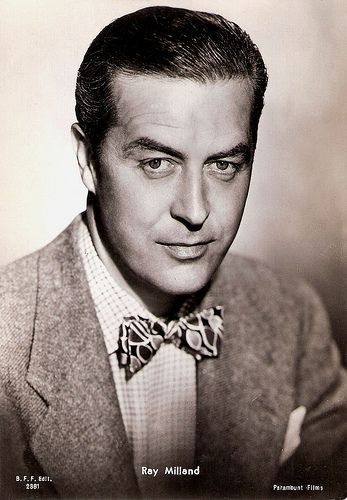
Italian postcard by Casa Editr. Ballerini & Fratini (B.F.F.), Firenze (Florence), no. 2381. Photo: Paramount Films.
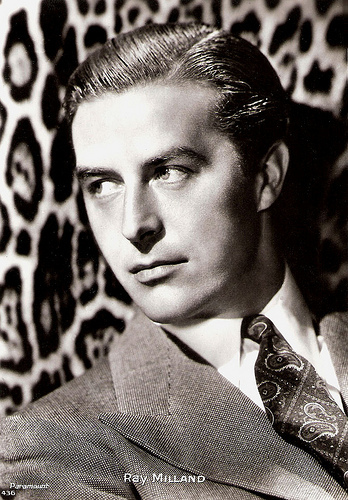
French postcard, no. 436. Photo: Paramount.
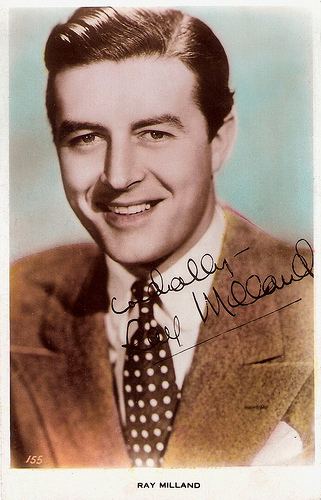
British postcard by Real Photograph, no. 155.
Fascinating Low-budget Horror Films
In 1955, Ray Milland started directing films, such as the western A Man Alone (Ray Milland, 1955) with Raymond Burr, and the well-paced espionager Lisbon (1956, Ray Milland) with Maureen O’Hara for Republic Pictures that he also produced and starred in. He did it with surprising proficiency, but the films failed to make him successful. He achieved more success with directing for television. According to Kit and Morgan Benson at Find A Grave , he “was considered a solid and capable director and producer.”
Milland returned as a film character actor in such fascinating low-budget horror films as The Premature Burial (Roger Corman, 1962) and The Man with the X-ray Eyes (Roger Corman, 1963), the latter providing Milland with the wittiest, most energetic role of his later career. He appeared in the TV classic Daughter of the Mind (Walter Grauman, 1969) in which he was reunited with Gene Tierney, and he played Ryan O'Neal's father in the hit tearjerker Love Story (Arthur Hiller, 1970).
He can also be seen in such dreadful horror films as The Thing with Two Heads (Lee Frost, 1972), the British Crazy House/The House in Nightmare Park (Peter Sykes, 1973), and Terror in the Wax Museum (Georg Fenady). One of the best of that bad lot is Frogs (George McCowan, 1972), a surprisingly enjoyable entry from the ‘nature-run-amok’ horror subgenre.
Milland wrote an autobiography, Wide Eyed in Babylon, published in 1974. Toward the end of his life, he guest starred in TV series as Battlestar Galactica (Glen A. Larson, 1978-1979) and the Harold Robbins’ adaptation The Dream Merchants (Vincent Sherman, 1980).
His last film was the Spanish fantasy-adventure The Sea Serpent (Gregory Greens, 1986) with Timothy Bottoms, after which his declining health forced him to retire. A book-loving homebody, Milland kept away from the Hollywood glitter and was rarely mentioned in the gossip columns.
At 81, he died of lung cancer in Torrance, California in 1986. He was survived by his wife, Muriel ‘Mal’ Weber, to whom he had been married since 1932. They had a son, Daniel, and an adopted daughter, Victoria. Frank Thompson at Film Reference : “Hollywood never quite knew what it had in Ray Milland, but he continuously showed himself to be an adventurous artist, always interested in exposing his established image to radical and surprising lights.”
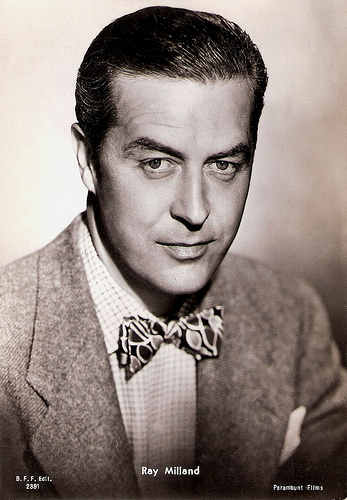
Italian postcard by Casa Editr. Ballerini & Fratini (B.F.F.), Firenze (Florence), no. 2381. Photo: Paramount Films.
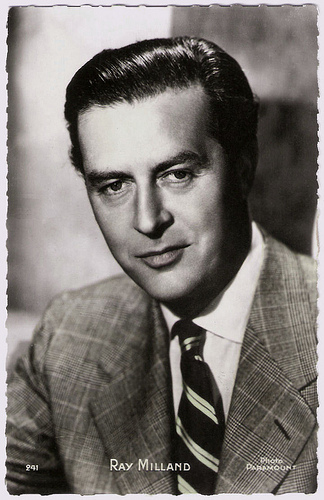
French postcard by Editions P.I., no. 241. Photo: Paramount, 1949.
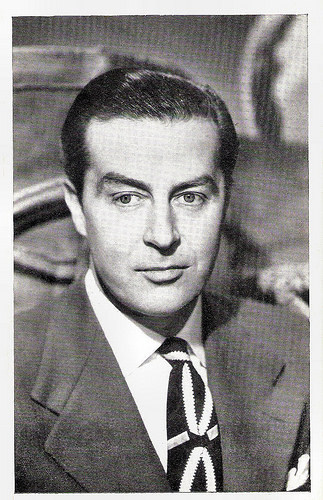
Vintage photo card.
Sources: Frank Thompson (Film Reference), Lynn Dougherty (Classic Movie Favorites), Kit and Morgan Benson (Find A Grave), Reel Classics, AllMovie, Wikipedia, and .

Dutch postcard by Takken, no. 3446. Photo: Paramount.

Italian postcard by Casa Editr. Ballerini & Fratini (B.F.F.), Firenze (Florence), no. 8618. Photo: Paramount Films.

Argentinian postcard, no. 54. Photo: Paramount.

Belgian collectors card by Kwatta, Bois d'Haine, no. C 319. Photo: M.G.M. Publicity still for A Life of Her Own (George Cukor, 1950).
Discovered by a Hollywood Talent Scout
Ray Milland was born Reginald Alfred John Truscott-Jones on a mountain called Cymla, above the town of Neath in Wales in 1905. Milland was the son of Alfred Jones and Elizabeth Annie (née Truscott). As a child, he took the name of his stepfather, Mullane, and was known in his early career as Jack Mullane. He later took his stage name Raymond Milland from the flat area of land called the mill lands in Neath, which he remembered fondly from his youth.
In 1925, Milland enlisted as a guardsman with the Royal Household Cavalry in London. As part of his training, he became skilled in fencing, boxing, horsemanship and marksmanship. An expert shot, he became a member of his company's rifle team, winning many prestigious competitions, including the Bisley Match in England.
When his duty service was completed in 1928, Milland stumbled into acting when a British filmmaker spotted him at a party and offered the 22-year-old a bit part in the romance The Plaything (Castleton Knight, 1929). More small and big roles in the British cinema and on stage followed. Among his British films were the silent ‘backstage’ drama Piccadilly (Ewald André Dupont, 1929) starring Anna May Wong , the adventure The Flying Scotsman (Castleton Knight, 1929) and the drama The Informer (Arthur Robison, 1929).
Raymond Milland was discovered by a Hollywood talent scout while performing on the stage in London, and travelled to America under a short-term contract with MGM. MGM shortened his first name to Ray and continued casting the acting novice in minor supporting roles.
MGM agreed to loan him out for more substantial parts in Will Rogers' Ambassador Bill (Sam Taylor, 1931) at Fox in which he tries to overthrow the boy-king of a fictional European country, and Warner Bros.' Blonde Crazy (Roy Del Ruth, 1931) in which he competes with con-artist James Cagney for Joan Blondell's affections.

British postcard in the Art Photo series, no. 38-1. Photo: publicity still for Tropic Holiday (Theodore Reed, 1938) with Dorothy Lamour.

British postcard, London, no. FS 191. Photo: Paramount. Publicity still for Beau Geste (William A. Wellman, 1939) with Robert Preston and Gary Cooper.

French postcard, no. 800. Photo: Paramount.

British postcard in the Caligraph Series, London, no. C 351. Photo: Paramount.
Long-term Contract at Paramount
When his contract with MGM expired, Ray Milland bounced around taking whatever roles he could get, including a supporting part in Fox's Charlie Chan in London (Eugene J. Forde, 1934). He returned to England for roles in This Is the Life (Albert de Courville, 1933) with Gordon Harker and the comedy Orders is Orders (Walter Forde, 1934), a satire on Hollywood movie-making.
Finally, based on the strength of two films he made with Carole Lombard - Bolero (Wesley Ruggles, 1934) and We’re Not Dressing (Norman Taurog, 1934) - as well as the endorsement of his leading lady, Paramount Pictures signed Milland to a long-term contract. He would remain with the studio for some twenty years.
Charming and debonair, he can be seen as suave, self-assured romantic leading man in a number of excellent drawing-room comedies, mysteries and adventures, including The Big Broadcast of 1937 (Mitchell Leisen, 1936), The Jungle Princess (William Thiele, 1936) featuring Dorothy Lamour, Beau Geste (William Wellman, 1939) with Gary Cooper, and I Wanted Wings (Mitchell Leisen, 1941) with Veronica Lake.
At Film Reference , Frank Thompson writes: “The quintessential Milland performances of the ‘leading man’ variety are contained in Leisen's delightful Easy Living and Kitty. The darker, more sinister side of his personality first came to the fore in Farrow's Alias Nick Beal, a film in which Milland plays the Devil himself.”
Easy Living (Mitchell Leisen, 1937) was a depression-era screwball comedy and social satire written by Preston Sturges and starring Jean Arthur. Reel Classics calls it “an often-overlooked delight”. Kitty (1945, Mitchell Leisen) was a variation on Pygmalion, in which a London aristocrat (Milland) takes it upon himself to make a lady of a guttersnipe (Paulette Goddard).
Milland had a terrible accident during the filming of Hotel Imperial (Henry Hathaway, 1939) with Isa Miranda , when, taking his horse over a jump, the saddle-girth broke and he landed head-first on a pile of bricks. His most serious injuries were a concussion that left him unconscious for 24 hours, a 3-inch gash in his skull that took 9 stitches to close, and numerous fractures and lacerations on his left hand.
When the Second World War began, Milland tried to enlist in the U.S. Army Air Forces, but was rejected because of his impaired left hand. He worked as a civilian flight instructor for the Army, and toured with a United Service Organisation (USO) South Pacific troupe in 1944.

British postcard by Real Photogravure.

Dutch postcard. Photo: Paramount.

British postcard in the Picturegoer Series, London, no. 991b. Photo: Paramount.

Dutch postcard. Photo: Paramount.
An Alcoholic Trying To Kick the Booze
Ray Milland had made over 60 feature films by the time he won an Oscar for his portrayal of an alcoholic trying to kick the booze in Billy Wilder's The Lost Weekend (1945). It would be pinnacle of Ray Milland's career and an acknowledgement of his serious dramatic abilities. The surprise shown by the critical establishment at Milland's proficiency in the role suggests that nothing much had ever been expected of him.
Milland was the first Welsh actor to ever win an Oscar. He was also the first actor not to have spoken a single word during his acceptance speech, preferring to simply bow his appreciation before casually walking to the stage exit. For this performance, he was also given an award at the first Cannes Film Festival.
Five years later, he gave a strong performance in Close to My Heart (William Keighley, 1951), starring with Gene Tierney as a couple trying to adopt a child. As Milland grew older and his value as a romantic lead began to wane, the more sinister aspects of this self-assuredness became more evident.
In 1954, he starred as the suave and mannerly accomplice opposite Grace Kelly in Dial M for Murder (Alfred Hitchcock, 1954). Other films that exploited the murderous glint in Milland's eloquent eyes include The Thief (Russel Rouse, 1951) a Film Noir without any dialogue, and The Girl in the Red Velvet Swing (Richard Fleischer, 1955) with Joan Collins .
He made many television appearances. He starred as a professor in the CBS sitcom Meet Mr. McNutley (1953-1955). The program was renamed in its second season as The Ray Milland Show. From 1959–1960, he starred in the CBS detective series Markham. In the late 1960s, he hosted rebroadcasts of certain episodes of the syndicated western anthology series, Death Valley Days under the title Trails West.

Italian postcard by Casa Editr. Ballerini & Fratini (B.F.F.), Firenze (Florence), no. 2381. Photo: Paramount Films.

French postcard, no. 436. Photo: Paramount.

British postcard by Real Photograph, no. 155.
Fascinating Low-budget Horror Films
In 1955, Ray Milland started directing films, such as the western A Man Alone (Ray Milland, 1955) with Raymond Burr, and the well-paced espionager Lisbon (1956, Ray Milland) with Maureen O’Hara for Republic Pictures that he also produced and starred in. He did it with surprising proficiency, but the films failed to make him successful. He achieved more success with directing for television. According to Kit and Morgan Benson at Find A Grave , he “was considered a solid and capable director and producer.”
Milland returned as a film character actor in such fascinating low-budget horror films as The Premature Burial (Roger Corman, 1962) and The Man with the X-ray Eyes (Roger Corman, 1963), the latter providing Milland with the wittiest, most energetic role of his later career. He appeared in the TV classic Daughter of the Mind (Walter Grauman, 1969) in which he was reunited with Gene Tierney, and he played Ryan O'Neal's father in the hit tearjerker Love Story (Arthur Hiller, 1970).
He can also be seen in such dreadful horror films as The Thing with Two Heads (Lee Frost, 1972), the British Crazy House/The House in Nightmare Park (Peter Sykes, 1973), and Terror in the Wax Museum (Georg Fenady). One of the best of that bad lot is Frogs (George McCowan, 1972), a surprisingly enjoyable entry from the ‘nature-run-amok’ horror subgenre.
Milland wrote an autobiography, Wide Eyed in Babylon, published in 1974. Toward the end of his life, he guest starred in TV series as Battlestar Galactica (Glen A. Larson, 1978-1979) and the Harold Robbins’ adaptation The Dream Merchants (Vincent Sherman, 1980).
His last film was the Spanish fantasy-adventure The Sea Serpent (Gregory Greens, 1986) with Timothy Bottoms, after which his declining health forced him to retire. A book-loving homebody, Milland kept away from the Hollywood glitter and was rarely mentioned in the gossip columns.
At 81, he died of lung cancer in Torrance, California in 1986. He was survived by his wife, Muriel ‘Mal’ Weber, to whom he had been married since 1932. They had a son, Daniel, and an adopted daughter, Victoria. Frank Thompson at Film Reference : “Hollywood never quite knew what it had in Ray Milland, but he continuously showed himself to be an adventurous artist, always interested in exposing his established image to radical and surprising lights.”

Italian postcard by Casa Editr. Ballerini & Fratini (B.F.F.), Firenze (Florence), no. 2381. Photo: Paramount Films.

French postcard by Editions P.I., no. 241. Photo: Paramount, 1949.

Vintage photo card.
Sources: Frank Thompson (Film Reference), Lynn Dougherty (Classic Movie Favorites), Kit and Morgan Benson (Find A Grave), Reel Classics, AllMovie, Wikipedia, and .
Published on February 10, 2016 22:00
February 9, 2016
Imported from the USA: Yvonne De Carlo
Dark-haired Hollywood beauty Yvonne De Carlo (1922–2007) was a Canadian American actress, singer, and dancer whose career in film, television, and musical theatre spanned six decades. From the 1950s on, she also starred in British and Italian films. She achieved her greatest popularity as the ghoulish matriarch Lily in the TV sitcom The Munsters (1964-1966).
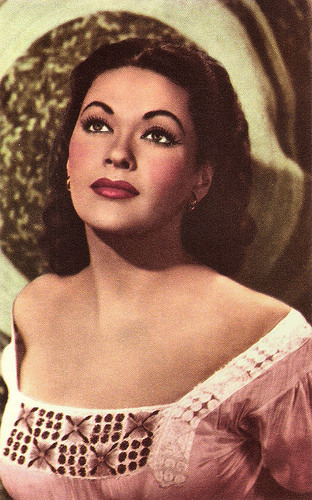
Belgian collectors card by Kwatta, Bois d'Haine, no. C 327. Photo: M.G.M. Publicity still for Sombrero (Norman Forster, 1953).
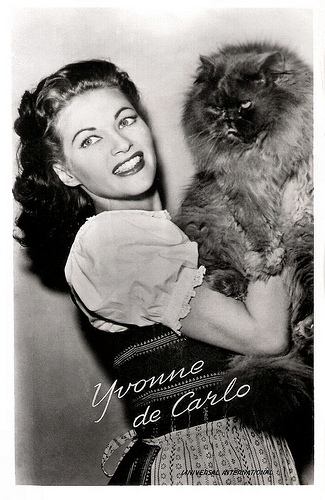
Dutch postcard by Takken, no. 3538. Photo: Universal International, 1949.
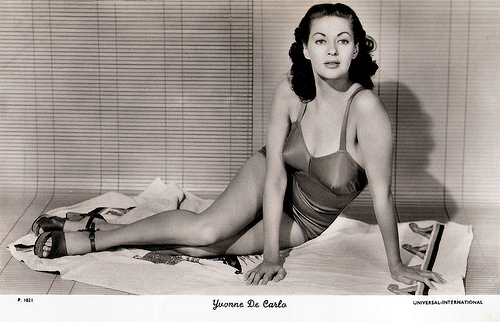
British postcard in The People series by Show Parade Picture Service, London, no. P. 1021. Photo: Universal-International.
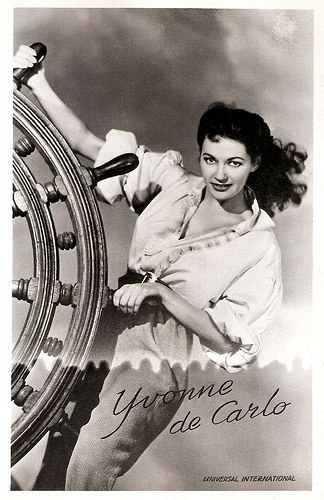
Dutch postcard by Takken, no. AX 144. Photo: Universal International. Publicity still for Buccaneer's Girl (Frederick De Cordova, 1950).
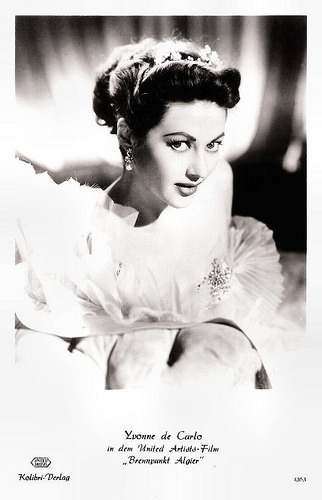
German postcard by Kolibri-Verlag, no. 1363. Photo: United Artists. Publicity still for Fort Algiers (Lesley Selander, 1953).
The most beautiful girl in the world
Yvonne De Carlo was born Margaret Yvonne Middleton in 1922 in West Point Grey (now part of Vancouver), British Columbia, Canada. She was the only child of William Middleton, an Australian-born salesman, and Marie DeCarlo, a French-born aspiring actress. Her father deserted the home, leaving her mother to make a living as a waitress. When De Carlo was ten her mother enrolled her in a local dance School and also saw that she studied dramatics. De Carlo and her mother made several trips to Los Angeles to seek fame and fortune in Hollywood.
In 1940, she was first runner-up to Miss Venice Beach, and she also came fifth in the 1940s Miss California competition. A year later, she landed a bit part as a bathing beauty in Harvard, Here I Come (Lew Landers, 1941). She also appeared in the three-minute Soundies musical, The Lamp of Memory (1942), shown in coin-operated movie jukeboxes. Other roles were slow to follow, and De Carlo took a job in the chorus line of Earl Carroll. During World War II she performed for U.S. servicemen and received many letters from GIs.
She got her big break when she was chosen over a reported 20,000 girls to play the lead role as a European seductress in the Technicolor spectacle Salome, Where She Danced (Charles Lamont, 1945), with Rod Cameron and Walter Slezak . She played a dancer during the Austrian-Prussian war who is forced to flee her country after she is accused of being a spy and ends up in a lawless western town in Arizona. Producer Walter Wanger described her as "the most beautiful girl in the world." Though not a critical success, it was a box office favourite, and the heavily-promoted De Carlo was hailed as an up-and-coming star. Universal signed her to a long-term contract.
De Carlo was given a small role in the prison film Brute Force (Jules Dassin, 1947), starring Burt Lancaster . Two years later she was again cast opposite Lancaster in her first important role in the classic Film Noir Criss Cross (Robert Siodmak, 1949). Claudio Carvalho at IMDb : " Burt Lancaster has an outstanding performance in the role of a honest man obsessed with his former wife, who becomes criminal trying to regain the love of his fickle ex-wife. Yvonne De Carlo is also perfect and very beautiful, in the role of a cold and manipulative woman, being a perfect 'femme-fatale'."
However, Universal preferred to cast De Carlo in more conventional fare, such as Casbah (John Berry, 1948) a musical remake of the 1938 film Algiers, the adventure film River Lady (George Sherman, 1948) and Buccaneer's Girl (Frederick de Cordova, 1950). In the latter she played a New Orleans singer who becomes involved with a Pirate Lord (Philip Friend).
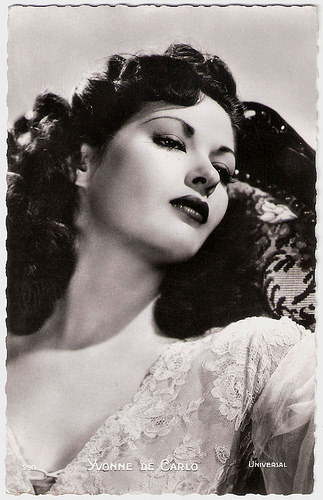
French postcard by Editions P.I., Paris, no. 298. Photo: Universal.
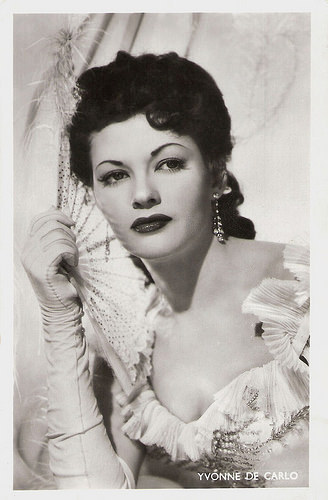
Dutch postcard by J. Sleding N.V., Amsterdam, no. 1250. Photo: Universal-International.
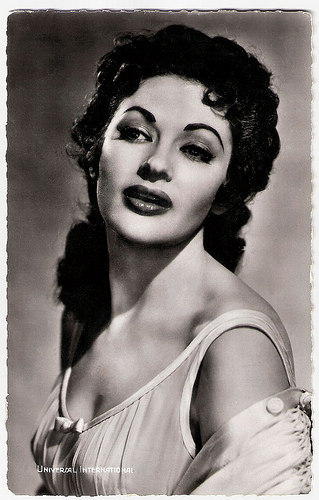
French postcard by Editions du Globe, no. 542. Photo: Universal-International.
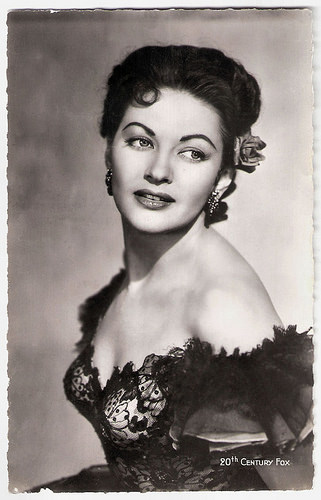
French postcard by Editions du Globe, no. 519. Photo: 20th Century Fox.
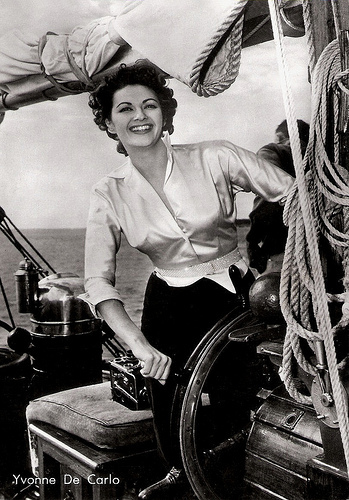
Italian postcard by Bromostampa, Milano, no. 209.
Lily Munster
When Yvonne De Carlo was in England making Hotel Sahara (Ken Annakin, 1951), she asked Universal for a release of her contract even though she still had three months to go. The studio agreed. De Carlo had always travelled extensively to promote her films and her appearances were widely publicised. In 1951 she became the first American star to visit Israel.
De Carlo regularly played in European films from now on. She starred in the British comedy The Captain's Paradise (Anthony Kimmins, 1953), about a captain of a ferry boat between the restricted British colony in Gibraltar and Spanish Morocco ( Alec Guinness ) who keeps two wives in separate ports. De Carlo of course played the hot-blooded mistress, Nita in Tangiers. She persuaded director Anthony Kimmins to talk Alec Guinness into doing the mambo with her in a night club sequence. Guinness, not usually thought of as a physical actor, consented to a week's worth of dance lessons from De Carlo and the sequence is one of the film's highlights.
In England, Yvonne De Carlo also co-starred with David Niven in the comedy Happy Ever After (Mario Zampi, 1954). Her film career reached its peak when director Cecil B. DeMille cast her as Sephora, the wife of Moses (Charlton Heston) in his biblical epic The Ten Commandments (1956). It was to be her most prominent role.
She later played a lead performance in the Civil War dramaBand of Angels (Raoul Walsh, 1957) with Clark Gable, starred as Mary Magdalene in the Italian biblical epic La spada e la croce/The Sword and the Cross (Carlo Ludovico Bragaglia, 1958), with Jorge Mistral and Rossana Podestà , and had a supporting role in the Western McLintock! (Andrew V. McLaglen, 1963) featuring John Wayne.
In 1964, De Carlo was deeply in debt, her film career was over and she was suffering from depression. Then, she was offered the role of Lily Munster, the wife of Herman Munster, in the legendary TV sitcom The Munsters (1964-1966). The Munsters are a weird but honest family. Herman, the father (Fred Gwynne) is Frankenstein's monster. Lily, his wife (Yvonne De Carlo) and the cigar-chomping Grandpa, her father (Al Lewis) are vampires. Their little son Eddie (Butch Patrick) is a werewolf. Their niece Marilyn (Pat Priest) is the only normal one. She is the ugly duck of the family. The sitcom went on the air in 1964 and lasted only two seasons, but achieved a kind of pop-culture immortality in decades of reruns and movie and television spinoffs.
Wolfgang Saxon in The New York Times : "In her cape and robes and with a streak of white in her black hair, Miss De Carlo’s Lily was a glamorous ghoul and a kind of Bride of Frankenstein as homemaker, “dusting” her gothic mansion at 1313 Mockingbird Lane with a vacuum cleaner set on reverse. The humor mostly derived from the family members’ oblivious belief that they were no different from their neighbors." After the show's cancellation, De Carlo reprised the role as Lily Munster in the Technicolor film Munster, Go Home! (Earl Bellamy, 1966).
After 1967, De Carlo became increasingly active in musicals, appearing in off-Broadway productions of Pal Joey and Catch Me If You Can. Her defining stage role was as Carlotta Campion in the original Broadway cast of Stephen Sondheim's musical Follies (1971-1972). Playing a washed-up star at a reunion of old theater colleagues, she introduced the song I'm Still Here, which would become well-known.
Yvonne De Carlo married stuntman Robert Drew Morgan, whom she met on the set of the Western Shotgun (Lesley Selander, 1955). They had two sons, Bruce Ross (1956) and Michael (1957-1997). After Bob Morgan's untimely accident, De Carlo was dismissed from her contract at Metro-Goldwyn-Mayer in 1960. Morgan became an alcoholic and they divorced in 1974.
De Carlo kept appearing in films and TV series. After her role in the TV Movie The Barefoot Executive (Susan Seidelman, 1995), she retired from acting at age 72. In 2007, she died from heart failure in Los Angeles. De Carlo was 84.
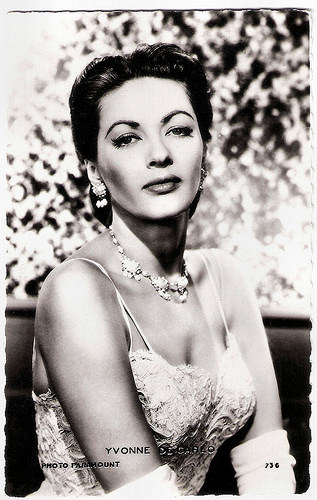
French postcard by Editions P.I., no. 736. Photo: Paramount, 1956.
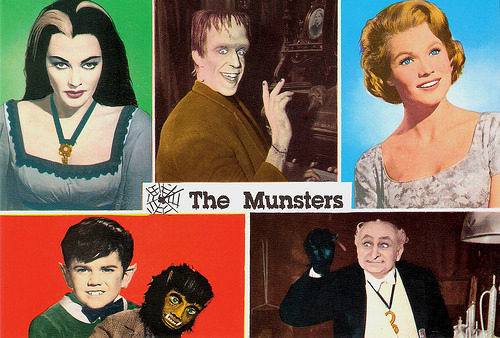
British postcard by Klasik Kards, London, no. 1514. Photos from the TV series The Munsters (1964-1966).
Burt Lancaster meets Yvonne De Carlo in Criss Cross (1949), also with Tony Curtis. Source: Felixxxx999 (YouTube).
Yvonne De Carlo sings I'll follow you in Fort Algiers (Lesley Selander, 1953) with Carlos Thompson and Raymond Burr. Source: Georges Gradzi (YouTube).
Yvonne De Carlo and Vittorio Gassman sing You Belong to My Heart in a deleted scene from Sombrero (Norman Foster, 1953). Source: Notorious Ediciones (YouTube).
Source: Wolfgang Saxon (The New York Times), and Wikipedia.

Belgian collectors card by Kwatta, Bois d'Haine, no. C 327. Photo: M.G.M. Publicity still for Sombrero (Norman Forster, 1953).

Dutch postcard by Takken, no. 3538. Photo: Universal International, 1949.

British postcard in The People series by Show Parade Picture Service, London, no. P. 1021. Photo: Universal-International.

Dutch postcard by Takken, no. AX 144. Photo: Universal International. Publicity still for Buccaneer's Girl (Frederick De Cordova, 1950).

German postcard by Kolibri-Verlag, no. 1363. Photo: United Artists. Publicity still for Fort Algiers (Lesley Selander, 1953).
The most beautiful girl in the world
Yvonne De Carlo was born Margaret Yvonne Middleton in 1922 in West Point Grey (now part of Vancouver), British Columbia, Canada. She was the only child of William Middleton, an Australian-born salesman, and Marie DeCarlo, a French-born aspiring actress. Her father deserted the home, leaving her mother to make a living as a waitress. When De Carlo was ten her mother enrolled her in a local dance School and also saw that she studied dramatics. De Carlo and her mother made several trips to Los Angeles to seek fame and fortune in Hollywood.
In 1940, she was first runner-up to Miss Venice Beach, and she also came fifth in the 1940s Miss California competition. A year later, she landed a bit part as a bathing beauty in Harvard, Here I Come (Lew Landers, 1941). She also appeared in the three-minute Soundies musical, The Lamp of Memory (1942), shown in coin-operated movie jukeboxes. Other roles were slow to follow, and De Carlo took a job in the chorus line of Earl Carroll. During World War II she performed for U.S. servicemen and received many letters from GIs.
She got her big break when she was chosen over a reported 20,000 girls to play the lead role as a European seductress in the Technicolor spectacle Salome, Where She Danced (Charles Lamont, 1945), with Rod Cameron and Walter Slezak . She played a dancer during the Austrian-Prussian war who is forced to flee her country after she is accused of being a spy and ends up in a lawless western town in Arizona. Producer Walter Wanger described her as "the most beautiful girl in the world." Though not a critical success, it was a box office favourite, and the heavily-promoted De Carlo was hailed as an up-and-coming star. Universal signed her to a long-term contract.
De Carlo was given a small role in the prison film Brute Force (Jules Dassin, 1947), starring Burt Lancaster . Two years later she was again cast opposite Lancaster in her first important role in the classic Film Noir Criss Cross (Robert Siodmak, 1949). Claudio Carvalho at IMDb : " Burt Lancaster has an outstanding performance in the role of a honest man obsessed with his former wife, who becomes criminal trying to regain the love of his fickle ex-wife. Yvonne De Carlo is also perfect and very beautiful, in the role of a cold and manipulative woman, being a perfect 'femme-fatale'."
However, Universal preferred to cast De Carlo in more conventional fare, such as Casbah (John Berry, 1948) a musical remake of the 1938 film Algiers, the adventure film River Lady (George Sherman, 1948) and Buccaneer's Girl (Frederick de Cordova, 1950). In the latter she played a New Orleans singer who becomes involved with a Pirate Lord (Philip Friend).

French postcard by Editions P.I., Paris, no. 298. Photo: Universal.

Dutch postcard by J. Sleding N.V., Amsterdam, no. 1250. Photo: Universal-International.

French postcard by Editions du Globe, no. 542. Photo: Universal-International.

French postcard by Editions du Globe, no. 519. Photo: 20th Century Fox.

Italian postcard by Bromostampa, Milano, no. 209.
Lily Munster
When Yvonne De Carlo was in England making Hotel Sahara (Ken Annakin, 1951), she asked Universal for a release of her contract even though she still had three months to go. The studio agreed. De Carlo had always travelled extensively to promote her films and her appearances were widely publicised. In 1951 she became the first American star to visit Israel.
De Carlo regularly played in European films from now on. She starred in the British comedy The Captain's Paradise (Anthony Kimmins, 1953), about a captain of a ferry boat between the restricted British colony in Gibraltar and Spanish Morocco ( Alec Guinness ) who keeps two wives in separate ports. De Carlo of course played the hot-blooded mistress, Nita in Tangiers. She persuaded director Anthony Kimmins to talk Alec Guinness into doing the mambo with her in a night club sequence. Guinness, not usually thought of as a physical actor, consented to a week's worth of dance lessons from De Carlo and the sequence is one of the film's highlights.
In England, Yvonne De Carlo also co-starred with David Niven in the comedy Happy Ever After (Mario Zampi, 1954). Her film career reached its peak when director Cecil B. DeMille cast her as Sephora, the wife of Moses (Charlton Heston) in his biblical epic The Ten Commandments (1956). It was to be her most prominent role.
She later played a lead performance in the Civil War dramaBand of Angels (Raoul Walsh, 1957) with Clark Gable, starred as Mary Magdalene in the Italian biblical epic La spada e la croce/The Sword and the Cross (Carlo Ludovico Bragaglia, 1958), with Jorge Mistral and Rossana Podestà , and had a supporting role in the Western McLintock! (Andrew V. McLaglen, 1963) featuring John Wayne.
In 1964, De Carlo was deeply in debt, her film career was over and she was suffering from depression. Then, she was offered the role of Lily Munster, the wife of Herman Munster, in the legendary TV sitcom The Munsters (1964-1966). The Munsters are a weird but honest family. Herman, the father (Fred Gwynne) is Frankenstein's monster. Lily, his wife (Yvonne De Carlo) and the cigar-chomping Grandpa, her father (Al Lewis) are vampires. Their little son Eddie (Butch Patrick) is a werewolf. Their niece Marilyn (Pat Priest) is the only normal one. She is the ugly duck of the family. The sitcom went on the air in 1964 and lasted only two seasons, but achieved a kind of pop-culture immortality in decades of reruns and movie and television spinoffs.
Wolfgang Saxon in The New York Times : "In her cape and robes and with a streak of white in her black hair, Miss De Carlo’s Lily was a glamorous ghoul and a kind of Bride of Frankenstein as homemaker, “dusting” her gothic mansion at 1313 Mockingbird Lane with a vacuum cleaner set on reverse. The humor mostly derived from the family members’ oblivious belief that they were no different from their neighbors." After the show's cancellation, De Carlo reprised the role as Lily Munster in the Technicolor film Munster, Go Home! (Earl Bellamy, 1966).
After 1967, De Carlo became increasingly active in musicals, appearing in off-Broadway productions of Pal Joey and Catch Me If You Can. Her defining stage role was as Carlotta Campion in the original Broadway cast of Stephen Sondheim's musical Follies (1971-1972). Playing a washed-up star at a reunion of old theater colleagues, she introduced the song I'm Still Here, which would become well-known.
Yvonne De Carlo married stuntman Robert Drew Morgan, whom she met on the set of the Western Shotgun (Lesley Selander, 1955). They had two sons, Bruce Ross (1956) and Michael (1957-1997). After Bob Morgan's untimely accident, De Carlo was dismissed from her contract at Metro-Goldwyn-Mayer in 1960. Morgan became an alcoholic and they divorced in 1974.
De Carlo kept appearing in films and TV series. After her role in the TV Movie The Barefoot Executive (Susan Seidelman, 1995), she retired from acting at age 72. In 2007, she died from heart failure in Los Angeles. De Carlo was 84.

French postcard by Editions P.I., no. 736. Photo: Paramount, 1956.

British postcard by Klasik Kards, London, no. 1514. Photos from the TV series The Munsters (1964-1966).
Burt Lancaster meets Yvonne De Carlo in Criss Cross (1949), also with Tony Curtis. Source: Felixxxx999 (YouTube).
Yvonne De Carlo sings I'll follow you in Fort Algiers (Lesley Selander, 1953) with Carlos Thompson and Raymond Burr. Source: Georges Gradzi (YouTube).
Yvonne De Carlo and Vittorio Gassman sing You Belong to My Heart in a deleted scene from Sombrero (Norman Foster, 1953). Source: Notorious Ediciones (YouTube).
Source: Wolfgang Saxon (The New York Times), and Wikipedia.
Published on February 09, 2016 22:00
February 8, 2016
Anna Pavlova
Anna Pavlova (1881–1931) was a Russian prima ballerina of the late 19th and the early 20th centuries. She was a principal artist of the Imperial Russian Ballet and the Ballets Russes of Sergei Diaghilev. Pavlova is most recognized for the creation of the role The Dying Swan and, with her own company, became the first ballerina to tour ballet around the world. She also appeared in a Hollywood film.
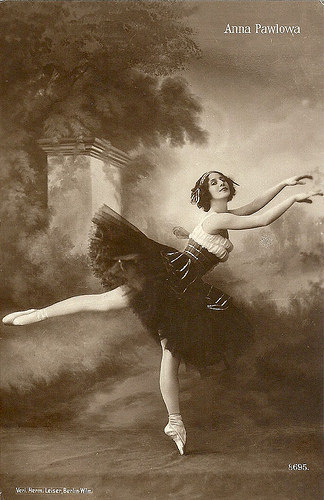
German postcard by Verlag Hermann Leiser, no. 8695. Collection: Didier Hanson.
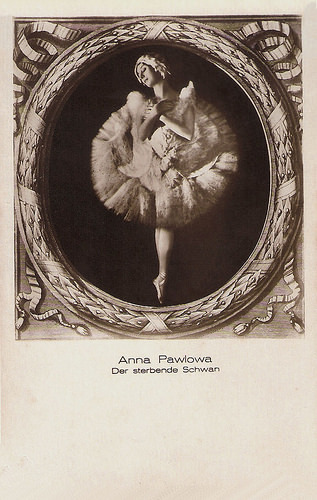
German postcard. Caption: Anna Pavlova in The Dying Swan.
The little savage
Anna Pavlovna (Matveyevna) Pavlova (Russian: Анна Павлова) was born in 1881 in Ligovo, near Saint Petersburg, in the Russian Empire to unwed parents. Her mother, Lyubov Feodorovna, was a laundress. Her father was rumoured to have been Jewish (some sources state that her biological father was the banker Lazar Polyakov). Her mother's second husband, Matvey Pavlov, is believed to have adopted her at the age of three, by which she acquired his last name.
Pavlova's passion for the art of ballet was ignited when her mother took her to a performance of Marius Petipa's original production of The Sleeping Beauty at the Imperial Maryinsky Theater. The lavish spectacle made an impression on Pavlova. At the age of nine, her mother took her to audition for the renowned Imperial Ballet School. Because of her youth, and what was considered her 'sickly' appearance, she was not chosen.
In 1891, she was finally accepted at the age of 10. She appeared for the first time on stage in Marius Petipa's Un conte de fées (A Fairy Tale), which the ballet master staged for the students of the school. Young Pavlova's years of training were difficult. Classical ballet did not come easily to her. Her severely arched feet, thin ankles, and long limbs clashed with the small and compact body in favour for the ballerina at the time.
Her fellow students taunted her with such nicknames as The broom and La petite sauvage (The little savage). Undeterred, Pavlova trained to improve her technique. She would practice and practice after learning a step. She took extra lessons from the noted teachers of the day — Christian Johansson, Pavel Gerdt, Nikolai Legat — and from Enrico Cecchetti, considered the greatest ballet virtuoso of the time and founder of the Cecchetti method, a very influential ballet technique used to this day.
In 1898, she entered the classe de perfection of Ekaterina Vazem, former Prima ballerina of the Saint Petersburg Imperial Theatres. During her final year at the Imperial Ballet School, she performed many roles with the principal company. She graduated in 1899 at age 18, chosen to enter the Imperial Ballet a rank ahead of corps de ballet as a coryphée.
She made her official début at the Mariinsky Theatre in Pavel Gerdt's Les Dryades prétendues (The False Dryads). Her performance drew praise from the critics, particularly the great critic and historian Nikolai Bezobrazov. At the height of Petipa's strict academicism, the public was taken aback by Anna Pavlova's style, a combination of a gift that paid little heed to academic rules: she frequently performed with bent knees, bad turnout, misplaced port de bras and incorrectly placed tours. Such a style in many ways harked back to the time of the romantic ballet and the great ballerinas of old.
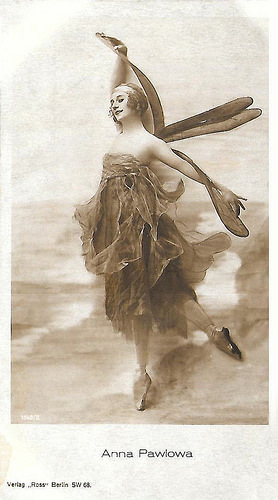
German postcard by Ross Verlag, Berlin, no. 1540/2, 1927-1928. Collection: Didier Hanson.
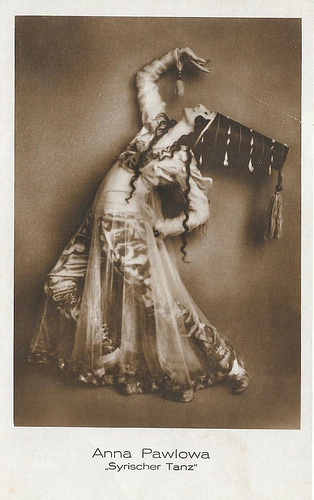
German postcard. Collection: Didier Hanson. Caption: Anna Pavlova in Syrian Dance.
The Dying Swan
Anna Pavlova performed in various classical variations, pas de deux and pas de trois in such ballets as La Camargo, Le Roi Candaule, Marcobomba and The Sleeping Beauty. Her enthusiasm often led her astray: once during a performance as the River Thames in Petipa's The Pharaoh's Daughter her energetic double pique turns led her to lose her balance, and she ended up falling into the prompter's box.
Her weak ankles led to difficulty while performing as the fairy Candide in Petipa's The Sleeping Beauty, leading the ballerina to revise the fairy's jumps en pointe, much to the surprise of the Ballet Master. She tried desperately to imitate the renowned Pierina Legnani, Prima ballerina assoluta of the Imperial Theaters. Once during class she attempted Legnani's famous fouettés, causing her teacher Pavel Gerdt to fly into a rage.
Pavlova rose through the ranks quickly, becoming a favourite of the old maestro Petipa. It was from Marius Petipa himself that Pavlova learned the title role in Paquita, Princess Aspicia in The Pharaoh's Daughter, Queen Nisia in Le Roi Candaule, and Giselle. She was named danseuse in 1902, première danseuse in 1905, and finally prima ballerina in 1906 after a resounding performance in Giselle. Petipa revised many grand pas for her, as well as many supplemental variations.
She was much celebrated by the fanatical balletomanes of Tsarist Saint Petersburg, her legions of fans calling themselves the Pavlovatzi. When the ballerina Mathilde Kschessinska was pregnant in 1901, she coached Pavlova in the role of Nikya in La Bayadère. Kschessinska, not wanting to be upstaged, was certain Pavlova would fail in the role, as she was considered technically inferior because of her small ankles and lithe legs. Instead audiences became enchanted with Pavlova and her frail, ethereal look, which fitted the role perfectly, particularly in the scene The Kingdom of the Shades.
Her feet were extremely rigid, so she strengthened her pointe shoe by adding a piece of hard wood on the soles for support and curving the box of the shoe. At the time, many considered this 'cheating', for a ballerina of the era was taught that she, not her shoes, must hold her weight en pointe. In Pavlova's case this was extremely difficult, as the shape of her feet required her to balance her weight on her little toes. Her solution became, over time, the precursor of the modern pointe shoe, as pointe work became less painful and easier for curved feet.
According to Margot Fonteyn's biography, Pavlova did not like the way her invention looked in photographs, so she would remove it or have the photographs altered so that it appeared she was using a normal pointe shoe. Pavlova is perhaps most renowned for creating the role of The Dying Swan, a solo choreographed for her by Michel Fokine. The ballet, created in 1905, is danced to Le cygne from The Carnival of the Animals by Camille Saint-Saëns. Pavlova also choreographed several solos herself, one of which is The Dragonfly, a short ballet set to music by Fritz Kreisler. While performing the role, Pavlova wore a gossamer gown with large dragonfly wings fixed to the back.
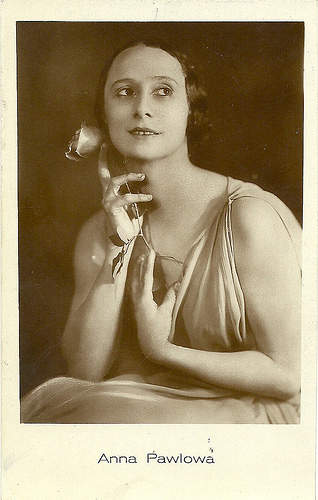
Vintage postcard. Collection: Didier Hanson.
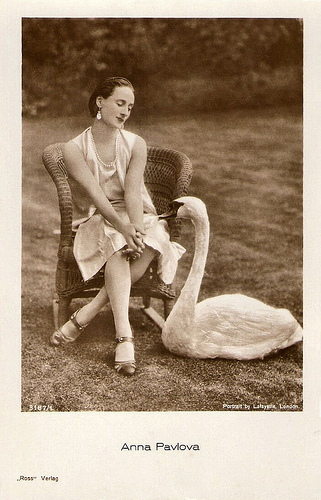
German postcard by Ross Verlag, no. 3187/1, 1928-1929. Photo: Lafayette, London.
Sergei Diaghilev
From 1908 till 1914, in the first years of the Ballets Russes, Anna Pavlova worked briefly for Sergei Diaghilev. Originally she was to dance the lead in Mikhail Fokine's The Firebird, but refused the part, as she could not come to terms with Igor Stravinsky's avant-garde score, and the role was given to Tamara Karsavina.
All her life Pavlova preferred the melodious 'musique dansante' of the old maestros such as Cesare Pugni and Ludwig Minkus, and cared little for anything else which strayed from the salon-style ballet music of the 19th century. By the early 20th century she had founded her own company and performed throughout the world, with a repertory consisting primarily of abridgements of Petipa's works, and specially choreographed pieces for herself. Members of her company included Kathleen Crofton.
After leaving Russia, Pavlova moved to London, England, settling, in 1912, at the Ivy House on North End Road, Golders Green, north of Hampstead Heath, where she lived for the rest of her life. The house had an ornamental lake where she fed her pet swans, and where now stands a statue of her by the Scots sculptor George Henry Paulin. While in London, Pavlova was influential in the development of British ballet, most notably inspiring the career of Alicia Markova.
Pavlova was introduced to audiences in the United States by Max Rabinoff during his time as managing director of the Boston Grand Opera Company from 1914 to 1917 and was featured there with her Russian Ballet Company during that period. In Hollywood, she met many film stars, including Charlie Chaplin and Mary Pickford.
She also starred in a silent film, The Dumb Girl of Portici (Phillips Smalley, Lois Weber, 1916). Bob Lipton in his review at IMDb : "Unhappily, while it probably worked very well at the time -- at least to the extent of letting audiences see the prima ballerina of the Russian ballet and in making it clear that real artists of the real arts would do movies -- this movie has not aged well. The melodramatic plot was typical of grand opera of the period, but modern tastes in stories are less grandiose and Miss Pavlova, while she moves beautifully, is clearly a stage actress and does not know how to tone down her performance for the screen."
While touring in The Hague, Pavlova was told that she had pneumonia and required an operation. She was also told that she would never be able to dance again if she went ahead with it. She refused to have the surgery, saying "If I can't dance then I'd rather be dead." She died of pleurisy, in the bedroom next to the Japanese Salon of the Hotel Des Indes in The Hague, three weeks short of her 50th birthday. In accordance with old ballet tradition, on the day she was to have next performed, the show went on as scheduled, with a single spotlight circling an empty stage where she would have been.
Memorial services were held in the Russian Orthodox Church in London. Anna Pavlova was cremated, and her ashes placed in a columbarium at Golders Green Crematorium, where her urn was adorned with her ballet shoes (which have since been stolen). Victor Dandré, her manager and companion, asserted he was her husband in his biography of the dancer in 1932: Anna Pavlova: In Art & Life. According to IMDb , he had married her in 1924. Pavlova's life was depicted in the TV series Anna Pavlova (Emil Loteanu, 1983), starring Galina Belyaeva.
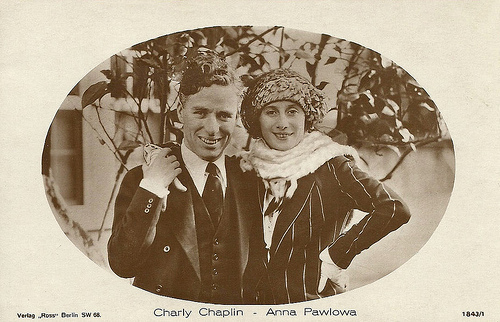
With Charlie Chaplin . German postcard by Ross Verlag, Berlin, no. 1843/1, 1927-1928. Collection: Didier Hanson.
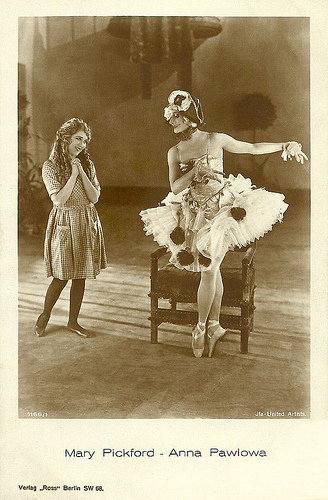
With Mary Pickford. German postcard by Ross Verlag, Berlin, no. 1166/1, 1927-1928. Photo: United Artists.
Sources: Bob Lipton (IMDb), (IMDb), Wikipedia and .

German postcard by Verlag Hermann Leiser, no. 8695. Collection: Didier Hanson.

German postcard. Caption: Anna Pavlova in The Dying Swan.
The little savage
Anna Pavlovna (Matveyevna) Pavlova (Russian: Анна Павлова) was born in 1881 in Ligovo, near Saint Petersburg, in the Russian Empire to unwed parents. Her mother, Lyubov Feodorovna, was a laundress. Her father was rumoured to have been Jewish (some sources state that her biological father was the banker Lazar Polyakov). Her mother's second husband, Matvey Pavlov, is believed to have adopted her at the age of three, by which she acquired his last name.
Pavlova's passion for the art of ballet was ignited when her mother took her to a performance of Marius Petipa's original production of The Sleeping Beauty at the Imperial Maryinsky Theater. The lavish spectacle made an impression on Pavlova. At the age of nine, her mother took her to audition for the renowned Imperial Ballet School. Because of her youth, and what was considered her 'sickly' appearance, she was not chosen.
In 1891, she was finally accepted at the age of 10. She appeared for the first time on stage in Marius Petipa's Un conte de fées (A Fairy Tale), which the ballet master staged for the students of the school. Young Pavlova's years of training were difficult. Classical ballet did not come easily to her. Her severely arched feet, thin ankles, and long limbs clashed with the small and compact body in favour for the ballerina at the time.
Her fellow students taunted her with such nicknames as The broom and La petite sauvage (The little savage). Undeterred, Pavlova trained to improve her technique. She would practice and practice after learning a step. She took extra lessons from the noted teachers of the day — Christian Johansson, Pavel Gerdt, Nikolai Legat — and from Enrico Cecchetti, considered the greatest ballet virtuoso of the time and founder of the Cecchetti method, a very influential ballet technique used to this day.
In 1898, she entered the classe de perfection of Ekaterina Vazem, former Prima ballerina of the Saint Petersburg Imperial Theatres. During her final year at the Imperial Ballet School, she performed many roles with the principal company. She graduated in 1899 at age 18, chosen to enter the Imperial Ballet a rank ahead of corps de ballet as a coryphée.
She made her official début at the Mariinsky Theatre in Pavel Gerdt's Les Dryades prétendues (The False Dryads). Her performance drew praise from the critics, particularly the great critic and historian Nikolai Bezobrazov. At the height of Petipa's strict academicism, the public was taken aback by Anna Pavlova's style, a combination of a gift that paid little heed to academic rules: she frequently performed with bent knees, bad turnout, misplaced port de bras and incorrectly placed tours. Such a style in many ways harked back to the time of the romantic ballet and the great ballerinas of old.

German postcard by Ross Verlag, Berlin, no. 1540/2, 1927-1928. Collection: Didier Hanson.

German postcard. Collection: Didier Hanson. Caption: Anna Pavlova in Syrian Dance.
The Dying Swan
Anna Pavlova performed in various classical variations, pas de deux and pas de trois in such ballets as La Camargo, Le Roi Candaule, Marcobomba and The Sleeping Beauty. Her enthusiasm often led her astray: once during a performance as the River Thames in Petipa's The Pharaoh's Daughter her energetic double pique turns led her to lose her balance, and she ended up falling into the prompter's box.
Her weak ankles led to difficulty while performing as the fairy Candide in Petipa's The Sleeping Beauty, leading the ballerina to revise the fairy's jumps en pointe, much to the surprise of the Ballet Master. She tried desperately to imitate the renowned Pierina Legnani, Prima ballerina assoluta of the Imperial Theaters. Once during class she attempted Legnani's famous fouettés, causing her teacher Pavel Gerdt to fly into a rage.
Pavlova rose through the ranks quickly, becoming a favourite of the old maestro Petipa. It was from Marius Petipa himself that Pavlova learned the title role in Paquita, Princess Aspicia in The Pharaoh's Daughter, Queen Nisia in Le Roi Candaule, and Giselle. She was named danseuse in 1902, première danseuse in 1905, and finally prima ballerina in 1906 after a resounding performance in Giselle. Petipa revised many grand pas for her, as well as many supplemental variations.
She was much celebrated by the fanatical balletomanes of Tsarist Saint Petersburg, her legions of fans calling themselves the Pavlovatzi. When the ballerina Mathilde Kschessinska was pregnant in 1901, she coached Pavlova in the role of Nikya in La Bayadère. Kschessinska, not wanting to be upstaged, was certain Pavlova would fail in the role, as she was considered technically inferior because of her small ankles and lithe legs. Instead audiences became enchanted with Pavlova and her frail, ethereal look, which fitted the role perfectly, particularly in the scene The Kingdom of the Shades.
Her feet were extremely rigid, so she strengthened her pointe shoe by adding a piece of hard wood on the soles for support and curving the box of the shoe. At the time, many considered this 'cheating', for a ballerina of the era was taught that she, not her shoes, must hold her weight en pointe. In Pavlova's case this was extremely difficult, as the shape of her feet required her to balance her weight on her little toes. Her solution became, over time, the precursor of the modern pointe shoe, as pointe work became less painful and easier for curved feet.
According to Margot Fonteyn's biography, Pavlova did not like the way her invention looked in photographs, so she would remove it or have the photographs altered so that it appeared she was using a normal pointe shoe. Pavlova is perhaps most renowned for creating the role of The Dying Swan, a solo choreographed for her by Michel Fokine. The ballet, created in 1905, is danced to Le cygne from The Carnival of the Animals by Camille Saint-Saëns. Pavlova also choreographed several solos herself, one of which is The Dragonfly, a short ballet set to music by Fritz Kreisler. While performing the role, Pavlova wore a gossamer gown with large dragonfly wings fixed to the back.

Vintage postcard. Collection: Didier Hanson.

German postcard by Ross Verlag, no. 3187/1, 1928-1929. Photo: Lafayette, London.
Sergei Diaghilev
From 1908 till 1914, in the first years of the Ballets Russes, Anna Pavlova worked briefly for Sergei Diaghilev. Originally she was to dance the lead in Mikhail Fokine's The Firebird, but refused the part, as she could not come to terms with Igor Stravinsky's avant-garde score, and the role was given to Tamara Karsavina.
All her life Pavlova preferred the melodious 'musique dansante' of the old maestros such as Cesare Pugni and Ludwig Minkus, and cared little for anything else which strayed from the salon-style ballet music of the 19th century. By the early 20th century she had founded her own company and performed throughout the world, with a repertory consisting primarily of abridgements of Petipa's works, and specially choreographed pieces for herself. Members of her company included Kathleen Crofton.
After leaving Russia, Pavlova moved to London, England, settling, in 1912, at the Ivy House on North End Road, Golders Green, north of Hampstead Heath, where she lived for the rest of her life. The house had an ornamental lake where she fed her pet swans, and where now stands a statue of her by the Scots sculptor George Henry Paulin. While in London, Pavlova was influential in the development of British ballet, most notably inspiring the career of Alicia Markova.
Pavlova was introduced to audiences in the United States by Max Rabinoff during his time as managing director of the Boston Grand Opera Company from 1914 to 1917 and was featured there with her Russian Ballet Company during that period. In Hollywood, she met many film stars, including Charlie Chaplin and Mary Pickford.
She also starred in a silent film, The Dumb Girl of Portici (Phillips Smalley, Lois Weber, 1916). Bob Lipton in his review at IMDb : "Unhappily, while it probably worked very well at the time -- at least to the extent of letting audiences see the prima ballerina of the Russian ballet and in making it clear that real artists of the real arts would do movies -- this movie has not aged well. The melodramatic plot was typical of grand opera of the period, but modern tastes in stories are less grandiose and Miss Pavlova, while she moves beautifully, is clearly a stage actress and does not know how to tone down her performance for the screen."
While touring in The Hague, Pavlova was told that she had pneumonia and required an operation. She was also told that she would never be able to dance again if she went ahead with it. She refused to have the surgery, saying "If I can't dance then I'd rather be dead." She died of pleurisy, in the bedroom next to the Japanese Salon of the Hotel Des Indes in The Hague, three weeks short of her 50th birthday. In accordance with old ballet tradition, on the day she was to have next performed, the show went on as scheduled, with a single spotlight circling an empty stage where she would have been.
Memorial services were held in the Russian Orthodox Church in London. Anna Pavlova was cremated, and her ashes placed in a columbarium at Golders Green Crematorium, where her urn was adorned with her ballet shoes (which have since been stolen). Victor Dandré, her manager and companion, asserted he was her husband in his biography of the dancer in 1932: Anna Pavlova: In Art & Life. According to IMDb , he had married her in 1924. Pavlova's life was depicted in the TV series Anna Pavlova (Emil Loteanu, 1983), starring Galina Belyaeva.

With Charlie Chaplin . German postcard by Ross Verlag, Berlin, no. 1843/1, 1927-1928. Collection: Didier Hanson.

With Mary Pickford. German postcard by Ross Verlag, Berlin, no. 1166/1, 1927-1928. Photo: United Artists.
Sources: Bob Lipton (IMDb), (IMDb), Wikipedia and .
Published on February 08, 2016 22:00
February 7, 2016
Erich Auer
Austrian actor Erich Auer (1923-2004) was an all-rounder. As a stage actor, he played 150 different roles on the Austrian stage. He appeared in Operettas at the Volkstheater and in character roles at the Burgtheater. Auer also became one of the handsome young heroes of the postwar Austrian and German cinema, especially in the Heimat film genre. Later he was often seen on TV and worked as a teacher and director.
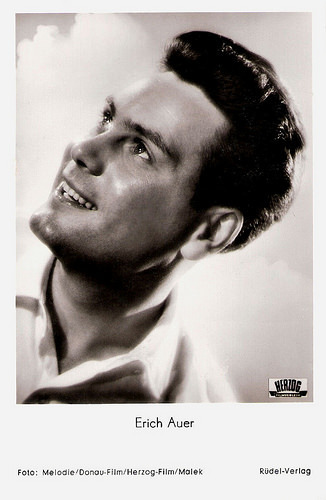
German postcard by Rüdel-Verlag. Photo: Melodie / Donau-Film / Herzog-Film / Malek. Publicity still for Der erste Kuß/The First Kiss (Erik Ode, 1954).
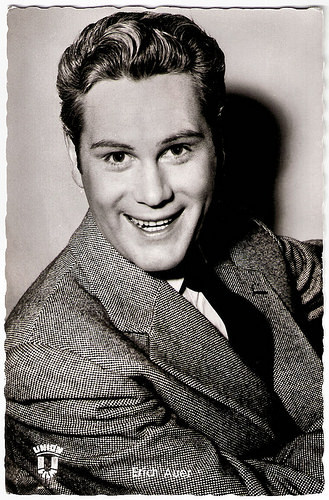
German postcard by Kolibri-Verlag, Minden-Westf., no. 2370. Photo: Union-Film. Publicity still for Das Hirtenlied vom Kaisertal/The Shepherd's Song from Kaisertal (Max Michel, 1956).
Awards and Honours
Erich Auer was born in 1923 in Innsbruck (some sources say Vienna), Austria. He came from a family of Tyrolean actors. Auer attended the teacher training college.
In the years 1941 to 1945, he had to report for duty in the Wehrmacht, but he came into Soviet captivity. After his release, he joined drama training at the Vienna Conservatory. There he met the actress Martha Wallner, whom he later married.
In 1946, he got his first engagement at the Linzer Landestheater. Two years later he returned to Vienna and acted until 1950 at the Volkstheater.
In 1951 he joined the ensemble of the Burgtheater. Here he played more than 150 roles in numerous classical and modern plays. Important roles were Creon in Sophocles' Oedipus the King, Biff in Arthur Miller's Death of a Salesman, Antonio in William Shakespeare's The Merchant of Venice, Valentin in Ferdinand Raimund’s Der Verschwender (The Spendthrift) and the old Merenberg in Franz Grillparzer's König Ottokars Glück und Ende (King Ottokar's Fortune and End).
Auer received many awards and honours for his work. In 1963 he was honoured with the title of ‘Kammerschauspieler’, in 1986 he became an honorary member of the Burgtheater and in 1989 he retired. From 1973 on, he was also a board member at the Burgtheater.
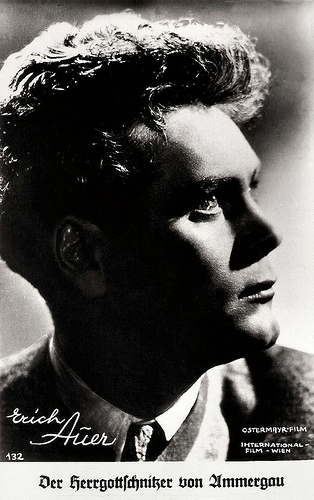
Austrian postcard by Verlag Hubmann (HDH Verlag), Wien, no. 132. Photo: Ostermayr-Film / International-Film-Wien. Publicity still for Der Herrgottschnitzer von Ammergau/The lord-carver of Ammergau (Harald Reinl, 1952).
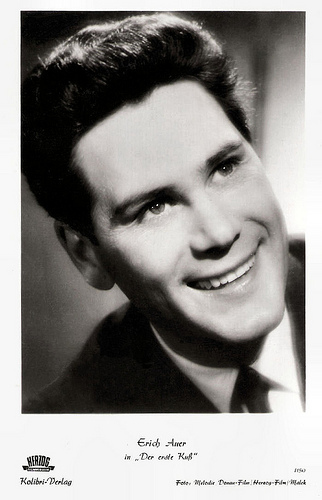
German postcard by Kolibri-Verlag, no. 1159. Photo: Melodie / Donau-Film / Herzog-Film / Malek. Publicity still for Der erste Kuss/The First Kiss (Erik Ode, 1954).
Light entertainment films
Beyond Vienna, Erich Auer was known for his roles in the German-speaking films of the post-war period. He made his film debut with a supporting part in the crime film Duell mit dem Tod/Duel with Death (Paul May, 1949).
In the cinema he had his breakthrough with the Operetta Der fidele Bauer/The Merry Farmer (Georg Marischka, 1951) as the son of Paul Hörbiger . Auer then appeared as Jeune Premier in many popular Heimat films of the era, including Der Herrgottschnitzer von Ammergau/The lord-carver of Ammergau (Harald Reinl, 1952), Der Klosterjäger/The Monastery's Hunter (Harald Reinl, 1953) with Marianne Koch , and Die Försterbuben/The Ranger boys (Robert A. Stemmle, 1955).
He was also the star of such Austrian and German light entertainment films as Ehestreik/Marriage strike (Joe Stöckel, 1953), Der erste Kuß/The First Kiss (Erik Ode, 1954) with the twin sisters Isa and Jutta Günther , and Der Pfarrer von St. Michael/The pastor of St. Michael (Wolfgang Glück, 1957).
In the 1960s he concentrated on stage and TV work. On television, he could be seen in many Austrian and German productions including stage adaptations of Friedrich Schiller’s Kabale und Liebe/Intrigue and Love (Gerhard Klingenberg, 1976) with Klaus Maria Brandauer. He also acted in the mini-series Die Alpensaga/The Alp saga (Dieter Berner, 1977) and an episode of the Krimi series Tatort (Jochen Bauer, 1982).
In his later years, he was also much in demand as a drama teacher. His last role was that of Colonel Pickering in My Fair Lady (2003-2004) at the Vienna Volksoper. Erich Auer passed away in 2004 in his hometown Vienna. He was 81.
Film Das Hirtenlied vom Kaisertal/The Shepherd's Song from Kaisertal (Max Michel, 1956). Source: Fritz 5140 (YouTube).
Sources: Wiener Zeitung (German), Austria-Forum (German), Wikipedia (German) and .

German postcard by Rüdel-Verlag. Photo: Melodie / Donau-Film / Herzog-Film / Malek. Publicity still for Der erste Kuß/The First Kiss (Erik Ode, 1954).

German postcard by Kolibri-Verlag, Minden-Westf., no. 2370. Photo: Union-Film. Publicity still for Das Hirtenlied vom Kaisertal/The Shepherd's Song from Kaisertal (Max Michel, 1956).
Awards and Honours
Erich Auer was born in 1923 in Innsbruck (some sources say Vienna), Austria. He came from a family of Tyrolean actors. Auer attended the teacher training college.
In the years 1941 to 1945, he had to report for duty in the Wehrmacht, but he came into Soviet captivity. After his release, he joined drama training at the Vienna Conservatory. There he met the actress Martha Wallner, whom he later married.
In 1946, he got his first engagement at the Linzer Landestheater. Two years later he returned to Vienna and acted until 1950 at the Volkstheater.
In 1951 he joined the ensemble of the Burgtheater. Here he played more than 150 roles in numerous classical and modern plays. Important roles were Creon in Sophocles' Oedipus the King, Biff in Arthur Miller's Death of a Salesman, Antonio in William Shakespeare's The Merchant of Venice, Valentin in Ferdinand Raimund’s Der Verschwender (The Spendthrift) and the old Merenberg in Franz Grillparzer's König Ottokars Glück und Ende (King Ottokar's Fortune and End).
Auer received many awards and honours for his work. In 1963 he was honoured with the title of ‘Kammerschauspieler’, in 1986 he became an honorary member of the Burgtheater and in 1989 he retired. From 1973 on, he was also a board member at the Burgtheater.

Austrian postcard by Verlag Hubmann (HDH Verlag), Wien, no. 132. Photo: Ostermayr-Film / International-Film-Wien. Publicity still for Der Herrgottschnitzer von Ammergau/The lord-carver of Ammergau (Harald Reinl, 1952).

German postcard by Kolibri-Verlag, no. 1159. Photo: Melodie / Donau-Film / Herzog-Film / Malek. Publicity still for Der erste Kuss/The First Kiss (Erik Ode, 1954).
Light entertainment films
Beyond Vienna, Erich Auer was known for his roles in the German-speaking films of the post-war period. He made his film debut with a supporting part in the crime film Duell mit dem Tod/Duel with Death (Paul May, 1949).
In the cinema he had his breakthrough with the Operetta Der fidele Bauer/The Merry Farmer (Georg Marischka, 1951) as the son of Paul Hörbiger . Auer then appeared as Jeune Premier in many popular Heimat films of the era, including Der Herrgottschnitzer von Ammergau/The lord-carver of Ammergau (Harald Reinl, 1952), Der Klosterjäger/The Monastery's Hunter (Harald Reinl, 1953) with Marianne Koch , and Die Försterbuben/The Ranger boys (Robert A. Stemmle, 1955).
He was also the star of such Austrian and German light entertainment films as Ehestreik/Marriage strike (Joe Stöckel, 1953), Der erste Kuß/The First Kiss (Erik Ode, 1954) with the twin sisters Isa and Jutta Günther , and Der Pfarrer von St. Michael/The pastor of St. Michael (Wolfgang Glück, 1957).
In the 1960s he concentrated on stage and TV work. On television, he could be seen in many Austrian and German productions including stage adaptations of Friedrich Schiller’s Kabale und Liebe/Intrigue and Love (Gerhard Klingenberg, 1976) with Klaus Maria Brandauer. He also acted in the mini-series Die Alpensaga/The Alp saga (Dieter Berner, 1977) and an episode of the Krimi series Tatort (Jochen Bauer, 1982).
In his later years, he was also much in demand as a drama teacher. His last role was that of Colonel Pickering in My Fair Lady (2003-2004) at the Vienna Volksoper. Erich Auer passed away in 2004 in his hometown Vienna. He was 81.
Film Das Hirtenlied vom Kaisertal/The Shepherd's Song from Kaisertal (Max Michel, 1956). Source: Fritz 5140 (YouTube).
Sources: Wiener Zeitung (German), Austria-Forum (German), Wikipedia (German) and .
Published on February 07, 2016 22:00
February 6, 2016
Lucy Di San Germano
Lucy Di San Germano aka Lucy Sangermano (1898-?) was an Italian silent film actress who peeked in the late 1910s and early 1920s.

Italian postcard by Ed. G. Vettori, Bologna, no. 13/1058. Photo: UCI (Unione Cinematografica Italiana).
War Propaganda
Lucy Di San Germano was born in Turin in 1898, originally named Lucia Moglia. She was the younger sister of actress Linda Moglia (1896-?). Very little is known about her private life.
Lucia got her actor’s name right from the start in film business, when she had a supporting act in the film Passa la gioventù/Youth passes (1917), directed by Achille Consalvi The film's star was Maria Campi, an older actress from the vaudeville, who had been producer of the film too.
The film was received negatively, in contrast to Sangermano’s next film, La maschera del barbaro/The mask of the barbarian (Paolo Trinchera, Ambrosio 1918), a war propaganda film about a sister who substitutes for a deserter, until he decides to return and sacrifice himself. Though the story was thin, the critics praised the performances of Francesco Casaleggio and Sangermano as the brother and sister.
From 1918 on, Di San Germano worked for years at Ambrosio, and often co-acted with regular supporting actors of those years, such as Dante Cappelli, Umberto Scalpellini, Vasco Creti, Ernesto and Ercole Vaser, Lidia Benelli a.o.
Under the pseudonym of Kismet, Paolo Trinchera directed Di San Germano again in an adaptation of Marcel Prévost: Chonchette (1918), about an officer of the Spahis (Roberto Villani) who suspects his daughter (Luisa Benelli) to be the fruit of an adulterous affair of his wife (Di San Germano) with his friend.
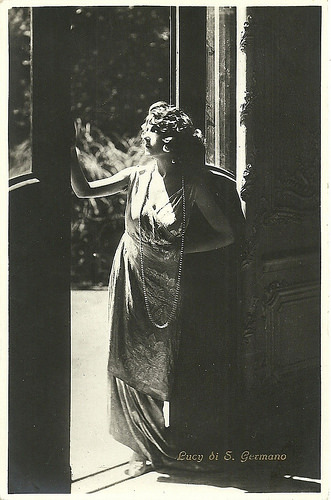
Italian postcard by Ed. G.B. Falci, Milano.
Real characters instead of mannequins
In December 1918, just when the First World War had ended, three films with Lucy Di San Germano were released.
Noblesse oblige (1918), based on a boulevard comedy by Hennequin and Veber, was apparently directed by the famous poster designer and illustrator Marcello Dudovich, whose only film direction this was. In addition to Di San Germano, her sister Linda Moglia also acted in the film.
Di San Germano also acted in Lagrime del popolo/Tears of the people, in which the forzuto (strong man) Alfredo Boccolini aka Galaor is involved in a drama of two families, one rich and immoral, and one working-class and honest. Di San Germano is the working class girl seduced by the rich young industrial’s son.
A third film released at the same time was …E dopo?/And then? (1918) directed by Febo Mari and with himself in the lead as a proud prime minister, a thinker, fighter, ascetic and legislator together, whose daughter (Di San Germano) instead falls for a sleek, elegant young man, her cousin (Luigi Cimara). She reveals him all kinds of top secrets with which the young man can speculate. While the high placed father fights corruption, misery and weakness, the little people finally manage to push him off his pedestal.
Febo Mari ’s film was praised in the press as a superb creation in which Mari had turned he actors in real characters instead of mannequins, while also praising the actor’s performance of all involved, including Di San Germano.
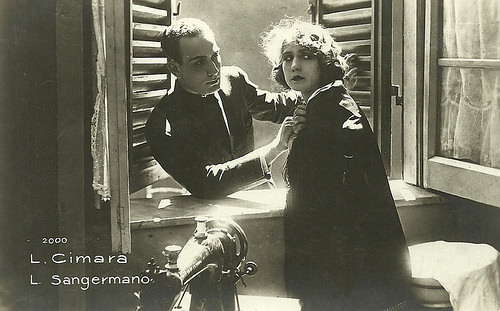
Italian postcard by G. Vettori, Bologna, no. 2000. Lucy Sangermano and Luigi Cimara acted twice together, in ...E dopo?.And then? (Febo Mari, 1918) and La rupe tarpea/The Tarpeian Rock (Gaston Ravel, 1920).
Moon Lover
Lucy Di San Germano had a lead in the film La gibigianna (1919), directed by the Ambrosio veteran Luigi Maggi and based on a popular play by Carlo Bertolazzi.
She plays Bianca, a porcelain factory worker who marries Enrico, the foreman (Sandro Ruffini), who has gone down the social ladder and hates wealth. Instead Bianca aspires to a high life and eventually drops him for a rich man. When he begs her to come back and she refuses, he strikes her with a knife and escapes, afraid he killed her. When overcome with grief, he is about to go to jail (another source says he is about to commit suicide), she saves him.
While La gibigianna was disliked in the Italian press, there was praise for the next film L’amante della luna (Achille Consalvi, 1919), based on a popular novel by Paul de Kock and starring Di San Germano and Villani. Villani is the Moon Lover who sleeps in daytime but sets things straight at night time.
The Italian newspaper La Stampa wrote at the time: “One of the most passionate dramas, which keeps the audience tied to the screen until the last word.” Di San Germano is the innocent girl who is about to succumb to a seductress avid for power and money, and in particular her acting was praised.
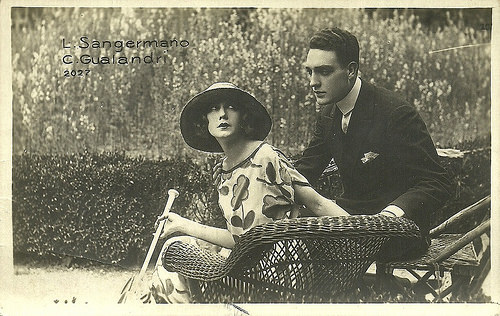
Italian postcard by G. Vettori, Bologna, no. 2027. Lucy Sangermano and Carlo Gualandri acted together in the film La rupe tarpea (Gaston Ravel, 1920).
A Charade gets Out of Hand
In 1919 Lucy Di San Germano moved over from Ambrosio to the Turinese Audax company for some lesser films: Il libro della vita/The Book of Life (1919) by Giuseppe Guarino, Inutile attesa/Needless waiting (Vittorio Tettoni, 1919), the adventure film La mano guantato di bianco/The white-gloved hand (Vittorio Tettoni, 1920) with forzuto Celio Bucchi, Le vicende dell’illusione/The events of illusion (Vittorio Tettoni, 1920) with Giovanni Cimara, and La roccia della morte/The rock of death (Vittorio Tettoni, 1920) with Tettoni himself.
More attention got the film La bambola e l’amore/The doll and love by diva film specialist Alfredo De Antoni, in which Di San Germano acted opposite Luigi Serventi and Tullio Carminati .
While audiences loved it, the press had reservations. The story deals with count Renato (Carminati) and writer Maurizio (Serventi) who love the same woman Cecyl (Di San Germano). After a duel between the men she chooses and marries the count. In Venice the writer finds Zanze, a lookalike of the woman (again Di San Germano), and stages a charade to convince the count his wife is committing adultery and to win the woman back. It gets out of hand. The count chases his wife who dies out in the streets, while he also kills the lookalike, holding her for his wife.
After La bambola della morte/The doll of death, Di San Germano acted at the same Rome based company Do-Re-Mi in another two films by De Antoni, Il mercante di emozioni/The Merchant of emotions (1921), with Serventi, De Antoni himself, and the leading man of Italian silent acting, Alberto Capozzi, and Il poeta e la principessa/The poet and the Princess (1921), with again Capozzi and De Antoni.
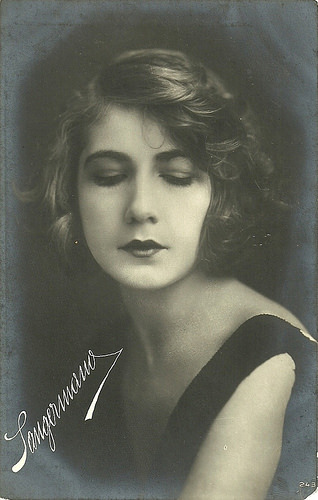
Italian postcard, no. 243.
Di San Germano’s penultimate two films
Around 1920 Lucy Di San Germano acted at various companies just once. She acted at Vay Film in La medaglia e il rovescio/The medal and the reverse (1920), directed by the Russian emigre Aleksandr Uralsky, and at Medusa Film in La rupe tarpea/The Tarpeian Rock (Gaston Ravel, 1921), with Luigi Cimara and Carlo Gualandri.
Di San Germano’s penultimate two films were at the Roman Cines company: L’incatenata/The chained (Augusto Genina, 1921), with Angelo Ferrari and Augusto Poggioli, and Il castello della malinconia/The castle of melancholy (Augusto Genina, 1922), with Ferrari, Poggioli, and Gemma De Sanctis.
Di San Germano’s last film was at the Turinese company Fert: L’inafferabile/The elusive (Mario Almirante, 1922), with Alberto Collo , Domenico Serra , Carlo and Olga Benetti, and Oreste Bilancia .
Collo plays a man who is robbed of all his belongings just before marrying a rich heiress (Di San Germano). Together they go after the thief, who is the least expected one: the loyal secretary.
Apparently, Di San Germano stopped her film career in 1922. Was the reason for her exit the decadence of the Italian film industry? Did she retire because she married?
Or was the reason for stopping her film career the contemporary competition of her sister Linda Moglia as Roxanne in the period piece Cirano de Bergerac by Augusto Genina? Cirano, which co-starred Ferrari as Christian, De Sanctis as the governess and Pierre Magnier as Cyrano, was released one year after in France, where it was a huge success in Paris, and was released in Italy only in 1926.
However, Linda Moglia, after one more film in 1924, also called her screen acting a day, just like her sister. It is unclear what happened with the sisters afterwards.
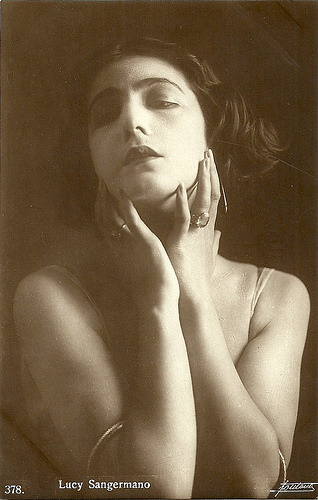
Italian postcard, no. 378. Photo Fontana.
Sources: Vittorio Martinelli (Il cinema muto italiano, 1917-1923 - Italian) and .

Italian postcard by Ed. G. Vettori, Bologna, no. 13/1058. Photo: UCI (Unione Cinematografica Italiana).
War Propaganda
Lucy Di San Germano was born in Turin in 1898, originally named Lucia Moglia. She was the younger sister of actress Linda Moglia (1896-?). Very little is known about her private life.
Lucia got her actor’s name right from the start in film business, when she had a supporting act in the film Passa la gioventù/Youth passes (1917), directed by Achille Consalvi The film's star was Maria Campi, an older actress from the vaudeville, who had been producer of the film too.
The film was received negatively, in contrast to Sangermano’s next film, La maschera del barbaro/The mask of the barbarian (Paolo Trinchera, Ambrosio 1918), a war propaganda film about a sister who substitutes for a deserter, until he decides to return and sacrifice himself. Though the story was thin, the critics praised the performances of Francesco Casaleggio and Sangermano as the brother and sister.
From 1918 on, Di San Germano worked for years at Ambrosio, and often co-acted with regular supporting actors of those years, such as Dante Cappelli, Umberto Scalpellini, Vasco Creti, Ernesto and Ercole Vaser, Lidia Benelli a.o.
Under the pseudonym of Kismet, Paolo Trinchera directed Di San Germano again in an adaptation of Marcel Prévost: Chonchette (1918), about an officer of the Spahis (Roberto Villani) who suspects his daughter (Luisa Benelli) to be the fruit of an adulterous affair of his wife (Di San Germano) with his friend.

Italian postcard by Ed. G.B. Falci, Milano.
Real characters instead of mannequins
In December 1918, just when the First World War had ended, three films with Lucy Di San Germano were released.
Noblesse oblige (1918), based on a boulevard comedy by Hennequin and Veber, was apparently directed by the famous poster designer and illustrator Marcello Dudovich, whose only film direction this was. In addition to Di San Germano, her sister Linda Moglia also acted in the film.
Di San Germano also acted in Lagrime del popolo/Tears of the people, in which the forzuto (strong man) Alfredo Boccolini aka Galaor is involved in a drama of two families, one rich and immoral, and one working-class and honest. Di San Germano is the working class girl seduced by the rich young industrial’s son.
A third film released at the same time was …E dopo?/And then? (1918) directed by Febo Mari and with himself in the lead as a proud prime minister, a thinker, fighter, ascetic and legislator together, whose daughter (Di San Germano) instead falls for a sleek, elegant young man, her cousin (Luigi Cimara). She reveals him all kinds of top secrets with which the young man can speculate. While the high placed father fights corruption, misery and weakness, the little people finally manage to push him off his pedestal.
Febo Mari ’s film was praised in the press as a superb creation in which Mari had turned he actors in real characters instead of mannequins, while also praising the actor’s performance of all involved, including Di San Germano.

Italian postcard by G. Vettori, Bologna, no. 2000. Lucy Sangermano and Luigi Cimara acted twice together, in ...E dopo?.And then? (Febo Mari, 1918) and La rupe tarpea/The Tarpeian Rock (Gaston Ravel, 1920).
Moon Lover
Lucy Di San Germano had a lead in the film La gibigianna (1919), directed by the Ambrosio veteran Luigi Maggi and based on a popular play by Carlo Bertolazzi.
She plays Bianca, a porcelain factory worker who marries Enrico, the foreman (Sandro Ruffini), who has gone down the social ladder and hates wealth. Instead Bianca aspires to a high life and eventually drops him for a rich man. When he begs her to come back and she refuses, he strikes her with a knife and escapes, afraid he killed her. When overcome with grief, he is about to go to jail (another source says he is about to commit suicide), she saves him.
While La gibigianna was disliked in the Italian press, there was praise for the next film L’amante della luna (Achille Consalvi, 1919), based on a popular novel by Paul de Kock and starring Di San Germano and Villani. Villani is the Moon Lover who sleeps in daytime but sets things straight at night time.
The Italian newspaper La Stampa wrote at the time: “One of the most passionate dramas, which keeps the audience tied to the screen until the last word.” Di San Germano is the innocent girl who is about to succumb to a seductress avid for power and money, and in particular her acting was praised.

Italian postcard by G. Vettori, Bologna, no. 2027. Lucy Sangermano and Carlo Gualandri acted together in the film La rupe tarpea (Gaston Ravel, 1920).
A Charade gets Out of Hand
In 1919 Lucy Di San Germano moved over from Ambrosio to the Turinese Audax company for some lesser films: Il libro della vita/The Book of Life (1919) by Giuseppe Guarino, Inutile attesa/Needless waiting (Vittorio Tettoni, 1919), the adventure film La mano guantato di bianco/The white-gloved hand (Vittorio Tettoni, 1920) with forzuto Celio Bucchi, Le vicende dell’illusione/The events of illusion (Vittorio Tettoni, 1920) with Giovanni Cimara, and La roccia della morte/The rock of death (Vittorio Tettoni, 1920) with Tettoni himself.
More attention got the film La bambola e l’amore/The doll and love by diva film specialist Alfredo De Antoni, in which Di San Germano acted opposite Luigi Serventi and Tullio Carminati .
While audiences loved it, the press had reservations. The story deals with count Renato (Carminati) and writer Maurizio (Serventi) who love the same woman Cecyl (Di San Germano). After a duel between the men she chooses and marries the count. In Venice the writer finds Zanze, a lookalike of the woman (again Di San Germano), and stages a charade to convince the count his wife is committing adultery and to win the woman back. It gets out of hand. The count chases his wife who dies out in the streets, while he also kills the lookalike, holding her for his wife.
After La bambola della morte/The doll of death, Di San Germano acted at the same Rome based company Do-Re-Mi in another two films by De Antoni, Il mercante di emozioni/The Merchant of emotions (1921), with Serventi, De Antoni himself, and the leading man of Italian silent acting, Alberto Capozzi, and Il poeta e la principessa/The poet and the Princess (1921), with again Capozzi and De Antoni.

Italian postcard, no. 243.
Di San Germano’s penultimate two films
Around 1920 Lucy Di San Germano acted at various companies just once. She acted at Vay Film in La medaglia e il rovescio/The medal and the reverse (1920), directed by the Russian emigre Aleksandr Uralsky, and at Medusa Film in La rupe tarpea/The Tarpeian Rock (Gaston Ravel, 1921), with Luigi Cimara and Carlo Gualandri.
Di San Germano’s penultimate two films were at the Roman Cines company: L’incatenata/The chained (Augusto Genina, 1921), with Angelo Ferrari and Augusto Poggioli, and Il castello della malinconia/The castle of melancholy (Augusto Genina, 1922), with Ferrari, Poggioli, and Gemma De Sanctis.
Di San Germano’s last film was at the Turinese company Fert: L’inafferabile/The elusive (Mario Almirante, 1922), with Alberto Collo , Domenico Serra , Carlo and Olga Benetti, and Oreste Bilancia .
Collo plays a man who is robbed of all his belongings just before marrying a rich heiress (Di San Germano). Together they go after the thief, who is the least expected one: the loyal secretary.
Apparently, Di San Germano stopped her film career in 1922. Was the reason for her exit the decadence of the Italian film industry? Did she retire because she married?
Or was the reason for stopping her film career the contemporary competition of her sister Linda Moglia as Roxanne in the period piece Cirano de Bergerac by Augusto Genina? Cirano, which co-starred Ferrari as Christian, De Sanctis as the governess and Pierre Magnier as Cyrano, was released one year after in France, where it was a huge success in Paris, and was released in Italy only in 1926.
However, Linda Moglia, after one more film in 1924, also called her screen acting a day, just like her sister. It is unclear what happened with the sisters afterwards.

Italian postcard, no. 378. Photo Fontana.
Sources: Vittorio Martinelli (Il cinema muto italiano, 1917-1923 - Italian) and .
Published on February 06, 2016 22:00
February 5, 2016
Jean Reno
Jean Reno (1948) is a Moroccan-born French actor of Spanish descent, with a low-key raspy voice. He became known for his many roles in films by director Luc Besson, including Le Grand Bleu/The Big Blue (1988), Nikita (1990), and Léon/Léon: The Professional (1994). Working in French, English, Japanese, Spanish, and Italian, he has appeared in numerous successful films such Mission: Impossible (1996), Godzilla (1998), Ronin (1998) and Crimson Rivers (2000).
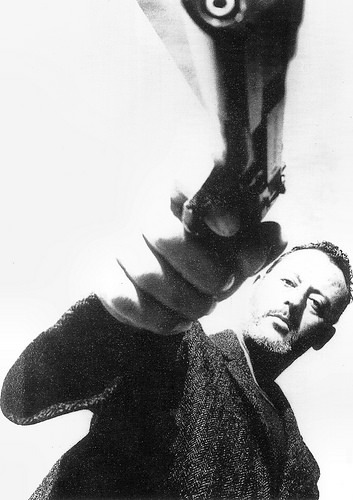
French postcard, no. PP 122. Photo: publicity still for Léon/Léon: The Professional (Luc Besson, 1994).
Calm Assassin
Jean Reno was born Juan Moreno y Herrera-Jiménez in Casablanca, Morocco, in 1948. His Spanish parents had moved to North Africa to find work and escape the dictatorship of Francisco Franco. He has a younger sister named María Teresa ‘Maite’. Their father was a linotypist. Their mother died when Juan was a teenager. He learned Spanish from his parents, and Arabic and French growing up in Morocco.
At the age of seventeen, Juan Moreno moved to France, where he studied acting at the Cours Simon School of Drama. When Moreno moved to France he served in the French army which was mandatory to gain his French citizenship. After he started to get acting jobs in France, Juan adopted the French version, Jean, of his name, and shortened his surname to Reno.
He had a role in every play of stage director Didier Flamand from 1977 to 1981, and then had the lead role in Flamand's first short film La vis/The notice (Didier Flamand, 1993). He made his film debut in the mystery film L'Hypothèse du tableau vole/The Hypothesis of the Stolen Painting (Raúl Ruiz, 1979). That same year he played a bit role as a policeman in Clair de femme/Womanlight (Costa-Gravas, 1979) with Romy Schneider .
Due to his large frame (1.88 m or 6 ft 2 in), Reno was called on to play ‘heavies’ in his early career. He had his first prominent role in the post-apocalyptic Fantasy film Le dernier combat/The Last Battle (Luc Besson, 1985). It was the first feature-film to be directed by Luc Besson. Wikipedia : “A dark vision of post-apocalyptic survival, the film was shot in black and white and contains only two words of dialogue. It depicts a world where people have been rendered mute by some unknown incident.”
In 1981, Besson and Reno had worked on the short film L'Avant Dernier/Before The Last. Reno and Besson became close personal friends, and Reno collaborated in films produced, written or directed by Besson, who became known as one of the masters of the ‘Cinéma du look style’ (French film directors who were said to favour style over substance, spectacle over narrative). Reno played a supporting part in Besson’s breakthrough film, Subway (Luc Besson, 1985), starring Isabelle Adjani and Christophe Lambert .
Reno's own breakthrough came with their next film, Le Grand Bleu/The Big Blue (Luc Besson, 1988). Cast as the comic rival of diver Jacques Mayhol (Jean-Marc Barr), Reno received international exposure when The Big Blue became a worldwide hit with both critics and audiences. Reno was nominated for a Best Supporting Actor César.
Of their joint work, those films that have achieved the most critical and commercial success are Nikita (Luc Besson, 1990) with Anne Parillaud, and Léon/Léon: The Professional (Luc Besson, 1994) with Gary Oldman and the young Natalie Portman. For his role as the calm assassin Léon, who reluctantly takes in 12-year-old girl Mathilda (Natalie Portman), Reno was nominated for the César in 1995. The film was a commercial success, grossing over $45 million worldwide on a $16 million budget.
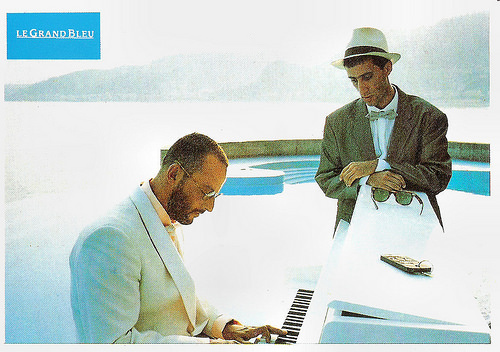
French postcard by Ciné Passion, no. GB 1. Photo: publicity still for Le Grand Bleu (Luc Besson, 1988) with Sergio Castellitto.
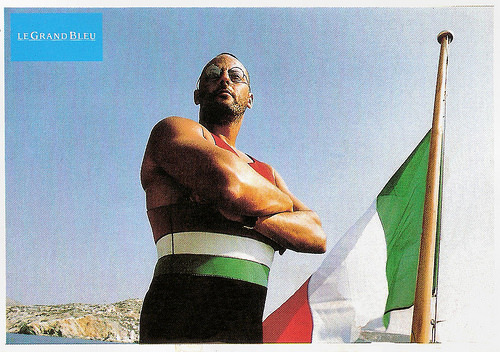
French postcard by Ciné Passion, no. GB 4. Photo: publicity still for Le Grand Bleu (Luc Besson, 1988).
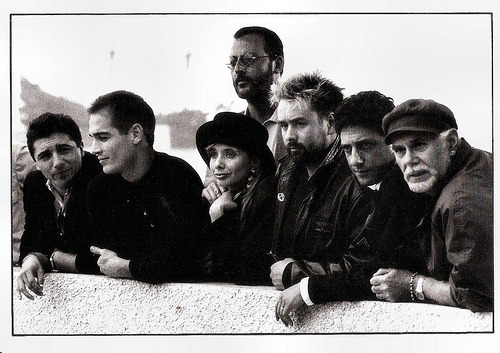
French postcard by News Productions, Beaulmes, no 56063. Photo: Eric Coiffier. Director and cast of Le Grand Bleu (Luc Besson, 1988) at the Festival de Cannes, 1988. With in the front row from left to right: Marc Duret, Jean-Marc Barr, Rosanna Arquette, Luc Besson, Sergio Castellitto and Andréas Voutsinas.
Disastrous wannabe summer blockbuster
From the 1990s on, Jean Reno appeared in international romantic-comedies and action films. He starred in several French box office hits. He played the servant of a 12th century knight (Christian Clavier) in the fantasy comedy Les Visiteurs/The Visitors (Jean-Marie Poiré, 1993), the Number 1 box office film in France in 1993. Reno and Clavier reprised their roles in a sequel, and the American remake Just Visiting (Jean-Marie Gaubert, 2001) with Christina Applegate.
Other French smashes were the psychological horror film Les Rivières Pourpres/The Crimson Rivers (Mathieu Kassovitz, 2000) with Vincent Kassel, and the comedy Décalage horaire/Jet Lag (Danièle Thompson, 2002) with Juliette Binoche.
Reno did the voice-over for Mufasa in the French-language version of the animation film The Lion King (Roger Allers, Rob Minkoff, 1994). He also played in such high-profile American films as the romantic comedy French Kiss (Lawrence Kasdan, 1995) with Meg Ryan and Kevin Kline, Mission: Impossible (Brian De Palma, 1996) with Tom Cruise, and Ronin (John Frankenheimer, 1998) with Robert De Niro.
To do the disastrous wannabe summer blockbuster Godzilla (Roland Emmerich, 1998), Reno turned down the role of Agent Smith in The Matrix (The Wachowski Brothers, 1999). The part would be played by Hugo Weaving.
In 2006, Reno had a prominent role in the remake of The Pink Panther (Shawn Levy, 2006) and its sequel, playing Gilbert Ponton, opposite Steve Martin as Inspector Clouseau. He portrayed Captain Bezu Fache in the film adaptation The Da Vinci Code (Ron Howard, 2006), starring Tom Hanks and Audrey Tautou.
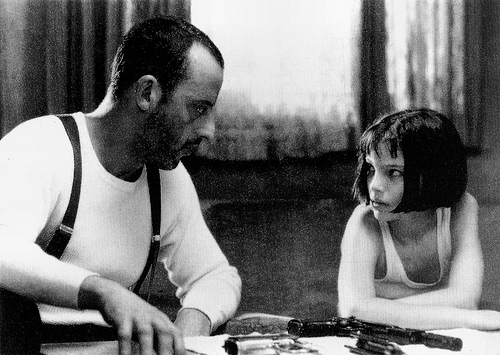
French postcard, no. PP 104. Photo: publicity still for Léon/Léon: The Professional (Luc Besson, 1994) with Natalie Portman.
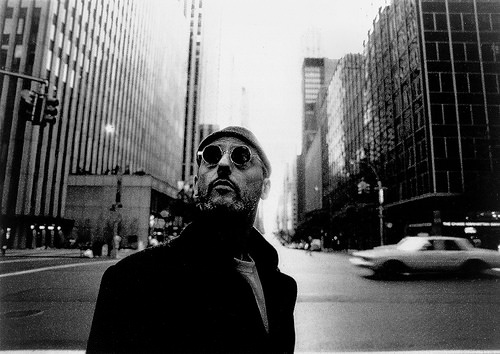
French postcard, no. PP 108. Photo: publicity still for Léon/Léon: The Professional (Luc Besson, 1994).
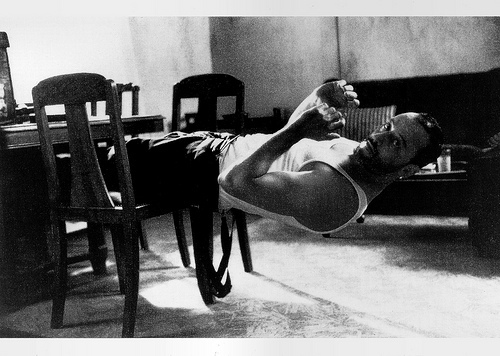
French postcard, no. PP 125. Photo: publicity still for Léon/Léon: The Professional (Luc Besson, 1994).
Mournful Eyes
In other media, Jean Reno was involved in the production of the third instalment in the popular Capcom game series Onimusha, Onimusha 3: Demon Siege (Minoru Nakai, 1994). For this action-adventure game, he lend his likeness to the protagonist Jacques Blanc, as well as provided the voice for the character's French dialogue.
In advertising work, Reno has appeared in American television commercials for UPS and portrayed Doraemon in a series of Toyota ads in Japan, as part of the ReBorn campaign.
Jean Reno married three time. His first wife was Geneviève Reno, with whom he has a daughter, Sandra (born 1978), and a son, Mickael (1980). They divorced in 1995. Reno's second wife was Nathalie Dyszkiewicz, a Polish model, with whom he has a son, Tom (1996), and a daughter, Serena (1998). They divorced in 2001.
In 2006, Reno married for the third time, to another Polish model and actress, Zofia Borucka. Then-presidential candidate Nicolas Sarkozy and singer Johnny Hallyday served as his best men (Reno endorsed Sarkozy for the 2007 French presidential election). Zofia and Reno have two sons, Cielo (2009) and Dean (2011). Reno maintains homes in Paris, Malaysia, and Los Angeles.
Upcoming films with Reno are the American drama The Last Face (Sean Penn, 2016) with Charlize Theron and Javier Bardem, and the historical drama The Promise (Terry George, 2016) starring Christian Bale.
Jason Buchanan describes Reno’s appeal at AllMovie : “With mournful eyes that suggest deep contemplation lurking beneath a sometimes imposing exterior, French actor Jean Reno (born July 30th, 1948) has carved a particular niche in cinema by portraying men who prefer to define themselves through action rather than words. Though his characters may often resort to violence without pause when necessary, that isn't to say that they are without the sort of honor or dignity that has served to define some of the screen's most memorable action stars.”
Trailer Le Grand Bleu/The Big Blue (1988). Source: Chaîne de adamparks55 (YouTube).
Trailer Ronin (1998). Source: Movieclips Trailer Vault (YouTube).
American trailer for Le Chef (2014). Source: Movieclips Film Festivals & Indie Films (YouTube).
Sources: Jason Buchanan (AllMovie), Wikipedia, and .

French postcard, no. PP 122. Photo: publicity still for Léon/Léon: The Professional (Luc Besson, 1994).
Calm Assassin
Jean Reno was born Juan Moreno y Herrera-Jiménez in Casablanca, Morocco, in 1948. His Spanish parents had moved to North Africa to find work and escape the dictatorship of Francisco Franco. He has a younger sister named María Teresa ‘Maite’. Their father was a linotypist. Their mother died when Juan was a teenager. He learned Spanish from his parents, and Arabic and French growing up in Morocco.
At the age of seventeen, Juan Moreno moved to France, where he studied acting at the Cours Simon School of Drama. When Moreno moved to France he served in the French army which was mandatory to gain his French citizenship. After he started to get acting jobs in France, Juan adopted the French version, Jean, of his name, and shortened his surname to Reno.
He had a role in every play of stage director Didier Flamand from 1977 to 1981, and then had the lead role in Flamand's first short film La vis/The notice (Didier Flamand, 1993). He made his film debut in the mystery film L'Hypothèse du tableau vole/The Hypothesis of the Stolen Painting (Raúl Ruiz, 1979). That same year he played a bit role as a policeman in Clair de femme/Womanlight (Costa-Gravas, 1979) with Romy Schneider .
Due to his large frame (1.88 m or 6 ft 2 in), Reno was called on to play ‘heavies’ in his early career. He had his first prominent role in the post-apocalyptic Fantasy film Le dernier combat/The Last Battle (Luc Besson, 1985). It was the first feature-film to be directed by Luc Besson. Wikipedia : “A dark vision of post-apocalyptic survival, the film was shot in black and white and contains only two words of dialogue. It depicts a world where people have been rendered mute by some unknown incident.”
In 1981, Besson and Reno had worked on the short film L'Avant Dernier/Before The Last. Reno and Besson became close personal friends, and Reno collaborated in films produced, written or directed by Besson, who became known as one of the masters of the ‘Cinéma du look style’ (French film directors who were said to favour style over substance, spectacle over narrative). Reno played a supporting part in Besson’s breakthrough film, Subway (Luc Besson, 1985), starring Isabelle Adjani and Christophe Lambert .
Reno's own breakthrough came with their next film, Le Grand Bleu/The Big Blue (Luc Besson, 1988). Cast as the comic rival of diver Jacques Mayhol (Jean-Marc Barr), Reno received international exposure when The Big Blue became a worldwide hit with both critics and audiences. Reno was nominated for a Best Supporting Actor César.
Of their joint work, those films that have achieved the most critical and commercial success are Nikita (Luc Besson, 1990) with Anne Parillaud, and Léon/Léon: The Professional (Luc Besson, 1994) with Gary Oldman and the young Natalie Portman. For his role as the calm assassin Léon, who reluctantly takes in 12-year-old girl Mathilda (Natalie Portman), Reno was nominated for the César in 1995. The film was a commercial success, grossing over $45 million worldwide on a $16 million budget.

French postcard by Ciné Passion, no. GB 1. Photo: publicity still for Le Grand Bleu (Luc Besson, 1988) with Sergio Castellitto.

French postcard by Ciné Passion, no. GB 4. Photo: publicity still for Le Grand Bleu (Luc Besson, 1988).

French postcard by News Productions, Beaulmes, no 56063. Photo: Eric Coiffier. Director and cast of Le Grand Bleu (Luc Besson, 1988) at the Festival de Cannes, 1988. With in the front row from left to right: Marc Duret, Jean-Marc Barr, Rosanna Arquette, Luc Besson, Sergio Castellitto and Andréas Voutsinas.
Disastrous wannabe summer blockbuster
From the 1990s on, Jean Reno appeared in international romantic-comedies and action films. He starred in several French box office hits. He played the servant of a 12th century knight (Christian Clavier) in the fantasy comedy Les Visiteurs/The Visitors (Jean-Marie Poiré, 1993), the Number 1 box office film in France in 1993. Reno and Clavier reprised their roles in a sequel, and the American remake Just Visiting (Jean-Marie Gaubert, 2001) with Christina Applegate.
Other French smashes were the psychological horror film Les Rivières Pourpres/The Crimson Rivers (Mathieu Kassovitz, 2000) with Vincent Kassel, and the comedy Décalage horaire/Jet Lag (Danièle Thompson, 2002) with Juliette Binoche.
Reno did the voice-over for Mufasa in the French-language version of the animation film The Lion King (Roger Allers, Rob Minkoff, 1994). He also played in such high-profile American films as the romantic comedy French Kiss (Lawrence Kasdan, 1995) with Meg Ryan and Kevin Kline, Mission: Impossible (Brian De Palma, 1996) with Tom Cruise, and Ronin (John Frankenheimer, 1998) with Robert De Niro.
To do the disastrous wannabe summer blockbuster Godzilla (Roland Emmerich, 1998), Reno turned down the role of Agent Smith in The Matrix (The Wachowski Brothers, 1999). The part would be played by Hugo Weaving.
In 2006, Reno had a prominent role in the remake of The Pink Panther (Shawn Levy, 2006) and its sequel, playing Gilbert Ponton, opposite Steve Martin as Inspector Clouseau. He portrayed Captain Bezu Fache in the film adaptation The Da Vinci Code (Ron Howard, 2006), starring Tom Hanks and Audrey Tautou.

French postcard, no. PP 104. Photo: publicity still for Léon/Léon: The Professional (Luc Besson, 1994) with Natalie Portman.

French postcard, no. PP 108. Photo: publicity still for Léon/Léon: The Professional (Luc Besson, 1994).

French postcard, no. PP 125. Photo: publicity still for Léon/Léon: The Professional (Luc Besson, 1994).
Mournful Eyes
In other media, Jean Reno was involved in the production of the third instalment in the popular Capcom game series Onimusha, Onimusha 3: Demon Siege (Minoru Nakai, 1994). For this action-adventure game, he lend his likeness to the protagonist Jacques Blanc, as well as provided the voice for the character's French dialogue.
In advertising work, Reno has appeared in American television commercials for UPS and portrayed Doraemon in a series of Toyota ads in Japan, as part of the ReBorn campaign.
Jean Reno married three time. His first wife was Geneviève Reno, with whom he has a daughter, Sandra (born 1978), and a son, Mickael (1980). They divorced in 1995. Reno's second wife was Nathalie Dyszkiewicz, a Polish model, with whom he has a son, Tom (1996), and a daughter, Serena (1998). They divorced in 2001.
In 2006, Reno married for the third time, to another Polish model and actress, Zofia Borucka. Then-presidential candidate Nicolas Sarkozy and singer Johnny Hallyday served as his best men (Reno endorsed Sarkozy for the 2007 French presidential election). Zofia and Reno have two sons, Cielo (2009) and Dean (2011). Reno maintains homes in Paris, Malaysia, and Los Angeles.
Upcoming films with Reno are the American drama The Last Face (Sean Penn, 2016) with Charlize Theron and Javier Bardem, and the historical drama The Promise (Terry George, 2016) starring Christian Bale.
Jason Buchanan describes Reno’s appeal at AllMovie : “With mournful eyes that suggest deep contemplation lurking beneath a sometimes imposing exterior, French actor Jean Reno (born July 30th, 1948) has carved a particular niche in cinema by portraying men who prefer to define themselves through action rather than words. Though his characters may often resort to violence without pause when necessary, that isn't to say that they are without the sort of honor or dignity that has served to define some of the screen's most memorable action stars.”
Trailer Le Grand Bleu/The Big Blue (1988). Source: Chaîne de adamparks55 (YouTube).
Trailer Ronin (1998). Source: Movieclips Trailer Vault (YouTube).
American trailer for Le Chef (2014). Source: Movieclips Film Festivals & Indie Films (YouTube).
Sources: Jason Buchanan (AllMovie), Wikipedia, and .
Published on February 05, 2016 22:00
February 4, 2016
EFSP's Dazzling Dozen: Stars & Cars
The year 1886 is regarded as the birth year of the modern car. The birth of the cinema followed only nine years later. These two symbols of the modern age often drove on together. Since the 1920s, nearly all cars have been mass-produced and around the globe, majestic movie palaces were built to entertain the masses. Both were symbols of glamour and luxury, and sometimes star postcards seem to promote not only the cinema but also the car industry. Surprising is the amount of female stars that were shown driving a car. So here are twelve postcards of stars with their new cars.
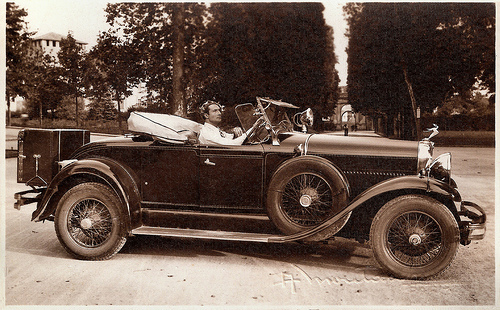
Nerio Bernardi . Italian postcard. Photo: Alberto Montacchini, Parma.
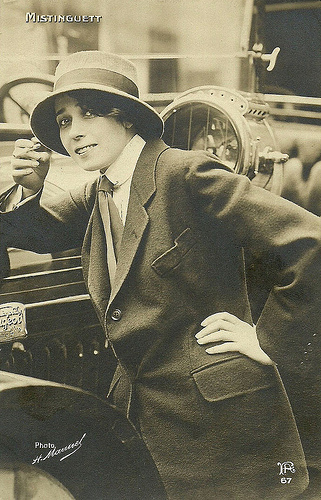
Mistinguett . French postcard by FA, no. 67. Photo: H. Manuel. Collection: Didier Hanson.
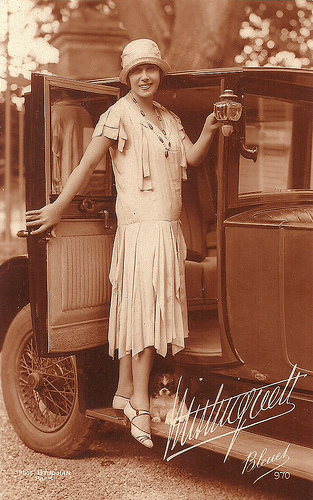
Mistinguett encore. French postcard by Bleuet, no. 970. Photo Utudjian, Paris.
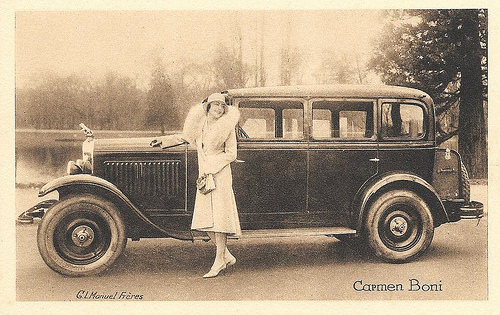
Carmen Boni . French postcard. Photo: G.L. Manuel Frères. Collection: Didier Hanson.
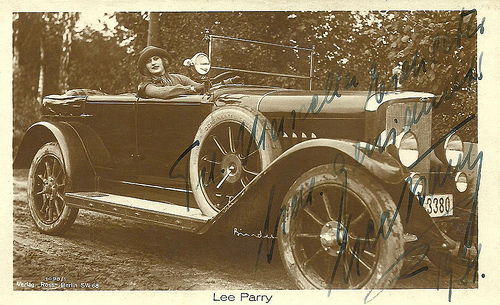
Lee Parry . German postcard by Ross Verlag, no. 1098/1, 1927-1928. Photo: Alex Binder, Berlin. Collection: Didier Hanson.
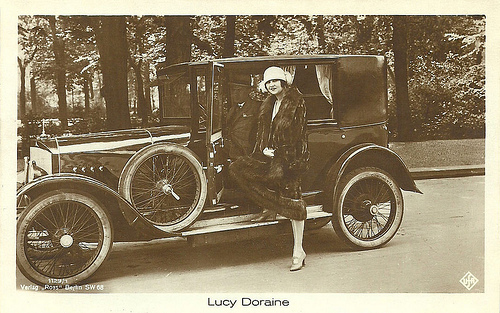
Lucy Doraine . German postcard by Ross Verlag, no. 1129/1, 1927-1928. Photo: Ufa. Collection: Didier Hanson.
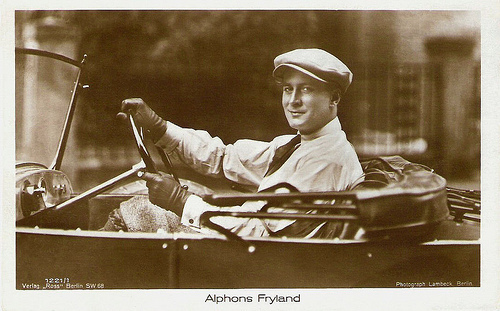
Alphons Fryland . German postcard by Ross Verlag, Berlin, no. 1221/1, 1927-1928. Photo: Lambeck, Berlin.
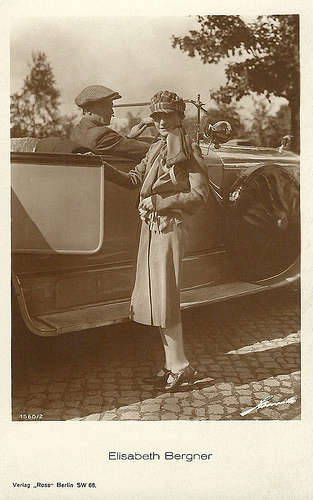
Elisabeth Bergner . German postcard by Ross Verlag, no. 1560/2, 1927-1928. Photo: Geiringer-Horovitz, Wien. Collection: Didier Hanson.
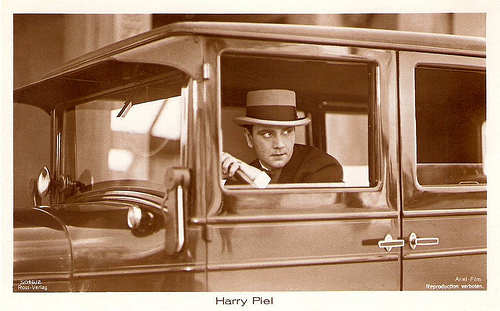
Harry Piel . German postcard by Ross Verlag, no. 5046/2, 1930-1931. Photo: Ariel Film.
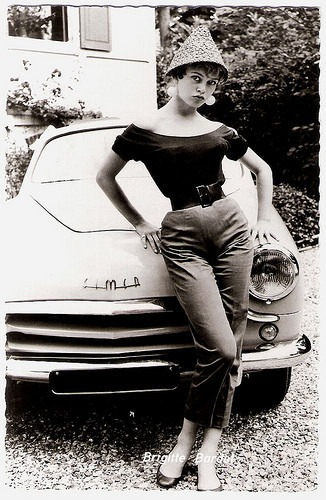
Brigitte Bardot . German postcard by Kolibri-Verlag, Minden/Westf., no. 998.
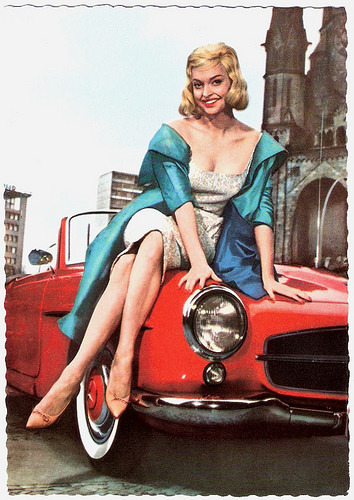
Nadja Tiller . German postcard by Ufa, Berlin-Tempelhoff, no. CK-170. Photo: Klaus Collignon / Ufa. Publicity still for Das Mädchen Rosemarie/The Girl Rosemarie (Rolf Thiele, 1958).
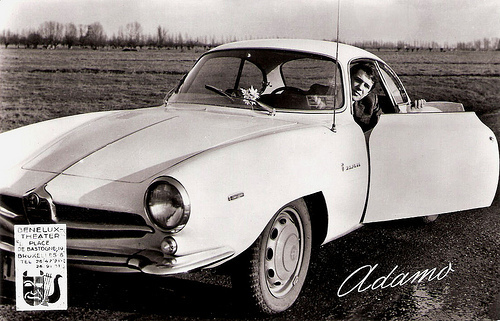
Adamo . Dutch postcard by 't Sticht, Utrecht, no. 6154. Photo: Benelux Theater, Bruxelles.
Source: Wikipedia.
This is a post for Postcard Friendship Friday, hosted by Beth at the The Best Hearts are Crunchy. You can visit her by clicking on the button below.


Nerio Bernardi . Italian postcard. Photo: Alberto Montacchini, Parma.

Mistinguett . French postcard by FA, no. 67. Photo: H. Manuel. Collection: Didier Hanson.

Mistinguett encore. French postcard by Bleuet, no. 970. Photo Utudjian, Paris.

Carmen Boni . French postcard. Photo: G.L. Manuel Frères. Collection: Didier Hanson.

Lee Parry . German postcard by Ross Verlag, no. 1098/1, 1927-1928. Photo: Alex Binder, Berlin. Collection: Didier Hanson.

Lucy Doraine . German postcard by Ross Verlag, no. 1129/1, 1927-1928. Photo: Ufa. Collection: Didier Hanson.

Alphons Fryland . German postcard by Ross Verlag, Berlin, no. 1221/1, 1927-1928. Photo: Lambeck, Berlin.

Elisabeth Bergner . German postcard by Ross Verlag, no. 1560/2, 1927-1928. Photo: Geiringer-Horovitz, Wien. Collection: Didier Hanson.

Harry Piel . German postcard by Ross Verlag, no. 5046/2, 1930-1931. Photo: Ariel Film.

Brigitte Bardot . German postcard by Kolibri-Verlag, Minden/Westf., no. 998.

Nadja Tiller . German postcard by Ufa, Berlin-Tempelhoff, no. CK-170. Photo: Klaus Collignon / Ufa. Publicity still for Das Mädchen Rosemarie/The Girl Rosemarie (Rolf Thiele, 1958).

Adamo . Dutch postcard by 't Sticht, Utrecht, no. 6154. Photo: Benelux Theater, Bruxelles.
Source: Wikipedia.
This is a post for Postcard Friendship Friday, hosted by Beth at the The Best Hearts are Crunchy. You can visit her by clicking on the button below.

Published on February 04, 2016 22:00
February 3, 2016
Hilde Maroff
Hildegard Maroff (1904-1984) was a German character actress, who started her film career in the silent cinema. She later managed the career of her son, Peter Bosse, who was a popular child star during the late 1930s. After the war, she was active in children's theatre.
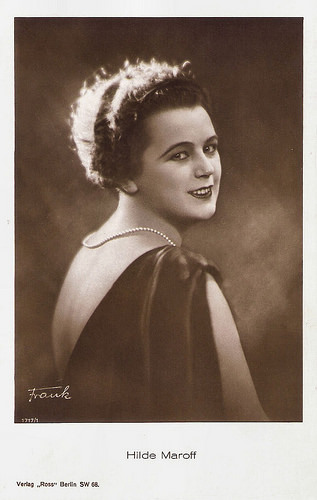
German postcard by Ross Verlag, no. 1717/1, 1927-1928. Photo: Frank.
The awakening of the wife
Hildegard Maroff was born in 1904 in Berlin, Germany.
At the age of 15, she already played a small page role on stage and then she took acting lessons from Meinhardt Bernauer. After a subsequent dance training, the Komödienhaus (the Comedy House) and the Berliner Theater (Berlin Theater) became her first stage stations.
From 1922 on, she also appeared in films. Her first major film role, she received in Kubinke, der Barbier, und die drei Dienstmädchen/Kubinke, the barber, and the three maids (Carl Boese, 1926). She, Erika Glässner and Käthe Haack were the three maids and the barber Kubinke was played by Werner Fuetterer .
Other silent films were Das Erwachen des Weibes/The awakening of the wife (Fred Sauer, 1927), Schwester Veronica/Sister Veronica (Gerhard Lamprecht, 1927) featuring Aud Egede Nissen , and Die drei Frauen von Urban Hell/The Three Women of Urban Hell (Jaap Speyer, 1928). Maroff also appeared in cabarets.
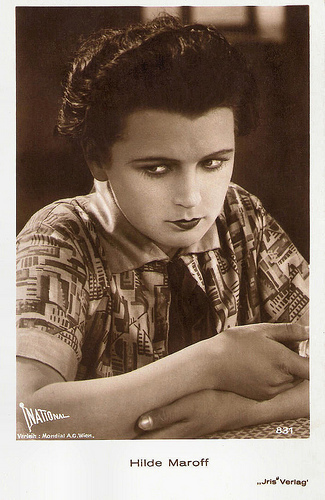
Austrian postcard by Iris-Verlag, no. 831. Photo: National / Verleih Mondial A.G., Wien.
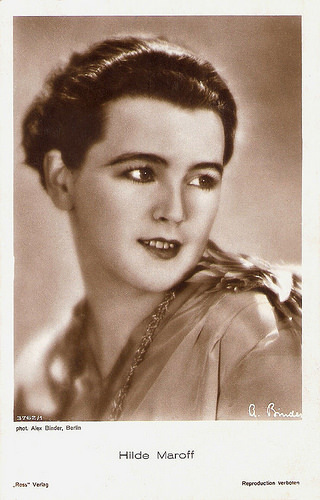
German postcard by Ross Verlag, no. 3762/1, 1928-1929. Photo: Alex Binder.
Paradise Road
In 1929 Hilde Maroff married Dr. Kurt Bosse and she interrupted temporarily her career. They had three children, Ilse (1929), Peter (1931) and Barbara (1935).
At the age of four, Peter Bosse already became a child star and Hilde Maroff managed his career. She then began to accept smaller roles and played three times at the side of her son. An example was Das Gäßchen zum Paradies/Paradise Road (Martin Fric, 1936) with Hans Moser .
During the war, her husband was killed. After the war, she had to take care for their children alone. She worked as a director at the Berlin Märchenbühne and headed the children's drama studio. She also played small roles at the Theater am Schiffbauerdamm and the Schillertheater.
Her daughter Barbara worked as a dancer with Mary Wigman, the noted German dancer and choreographer, who was the pioneer of expressionist dance, dance therapy, and movement training without pointe shoes.
After a long illness, Hilde Maroff died in 1984 in her homeplace Berlin. She was 80.
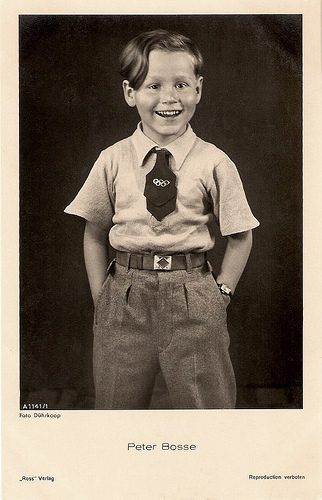
Peter Bosse . German Postcard by Ross Verlag, no. A1276/1. 1937-1938. Photo: Manassée-Ricoll, Wien / Mondial.
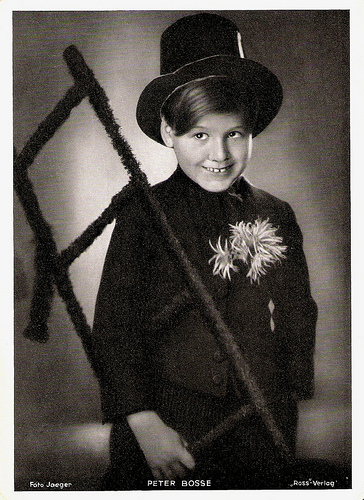
Peter Bosse . Big German card by Ross Verlag. Photo: Joerger.
Sources: Wikipedia (German) and .

German postcard by Ross Verlag, no. 1717/1, 1927-1928. Photo: Frank.
The awakening of the wife
Hildegard Maroff was born in 1904 in Berlin, Germany.
At the age of 15, she already played a small page role on stage and then she took acting lessons from Meinhardt Bernauer. After a subsequent dance training, the Komödienhaus (the Comedy House) and the Berliner Theater (Berlin Theater) became her first stage stations.
From 1922 on, she also appeared in films. Her first major film role, she received in Kubinke, der Barbier, und die drei Dienstmädchen/Kubinke, the barber, and the three maids (Carl Boese, 1926). She, Erika Glässner and Käthe Haack were the three maids and the barber Kubinke was played by Werner Fuetterer .
Other silent films were Das Erwachen des Weibes/The awakening of the wife (Fred Sauer, 1927), Schwester Veronica/Sister Veronica (Gerhard Lamprecht, 1927) featuring Aud Egede Nissen , and Die drei Frauen von Urban Hell/The Three Women of Urban Hell (Jaap Speyer, 1928). Maroff also appeared in cabarets.

Austrian postcard by Iris-Verlag, no. 831. Photo: National / Verleih Mondial A.G., Wien.

German postcard by Ross Verlag, no. 3762/1, 1928-1929. Photo: Alex Binder.
Paradise Road
In 1929 Hilde Maroff married Dr. Kurt Bosse and she interrupted temporarily her career. They had three children, Ilse (1929), Peter (1931) and Barbara (1935).
At the age of four, Peter Bosse already became a child star and Hilde Maroff managed his career. She then began to accept smaller roles and played three times at the side of her son. An example was Das Gäßchen zum Paradies/Paradise Road (Martin Fric, 1936) with Hans Moser .
During the war, her husband was killed. After the war, she had to take care for their children alone. She worked as a director at the Berlin Märchenbühne and headed the children's drama studio. She also played small roles at the Theater am Schiffbauerdamm and the Schillertheater.
Her daughter Barbara worked as a dancer with Mary Wigman, the noted German dancer and choreographer, who was the pioneer of expressionist dance, dance therapy, and movement training without pointe shoes.
After a long illness, Hilde Maroff died in 1984 in her homeplace Berlin. She was 80.

Peter Bosse . German Postcard by Ross Verlag, no. A1276/1. 1937-1938. Photo: Manassée-Ricoll, Wien / Mondial.

Peter Bosse . Big German card by Ross Verlag. Photo: Joerger.
Sources: Wikipedia (German) and .
Published on February 03, 2016 22:00
February 2, 2016
Fien de la Mar
Tonight at the International Film Festival Rotterdam is the world premiere of Ik wil gelukkig zijn/One Life is not enough (2016). Annette Apon directed this documentary about one of the few real film stars of the Netherlands, Fien de la Mar (1898-1965). This Dutch Diva starred in several films during the 1930s when a Dutch Hollywood was created by German emigrants like Richard Oswald, Ludwig Berger and Max Ophüls. Fien sang a song about this curious phenomenon in the short film Hollandsch Hollywood/Dutch Hollywood (Ernst Winar, 1933).
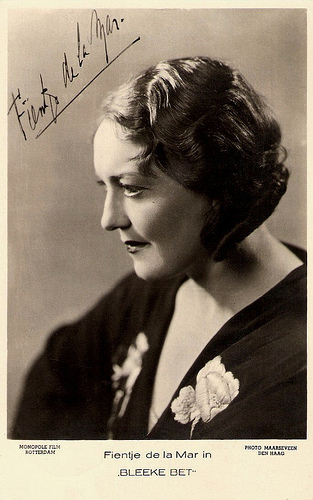
Dutch Postcard by Monopole Film, Rotterdam. Photo: Dick van Maarseveen. Publicity still for Bleeke Bet (1934).
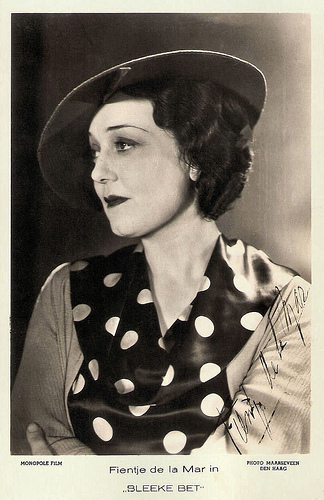
Dutch postcard by M.B. & Z. (M. Bonnist & Zonen, Amsterdam). Photo: Dick van Maarseveen, Den Haag / Monopole Film. Publicity still of Fien(tje) de la Mar in Bleeke Bet (Alex Benno, Richard Oswald, 1934). Collection: Egbert Barten.
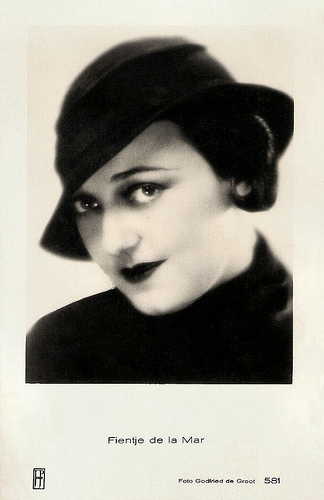
Dutch postcard by JosPe. Sent by mail in 1935. Photo: Godfried de Groot .
Capricious
Before WW II, the actress and cabaret artist was known as Fientje de la Mar. She was born in 1898 and named after Josephine de Beauharnais, the first wife of Napoleon Bonaparte.
Her grandfather Charles de la Mar was an admirer of the French emperor and had called his son Napoleon (Nap). Both were famous Dutch actors and Fien started her stage career in 1917 when she was still a school girl.
Immediately Fientje showed talent but also a huge temper. She would become a glamorous and capricious stage star, who loved liquor and would have many lovers.
Her feature film debut was the extremely successful musical De Jantjes/The Tars (Jaap Speyer, 1934), one of the first Dutch sound films. The three title characters were played by Willy Costello , Johan Kaart and Fien's lover Jan van Ees .
Fien's second feature was Bleeke Bet (Richard Oswald, Alex Benno, 1934). In this film she sings her torch song Ik wil gelukkig zijn (I want to be happy).
Bleeke Bet (1934) was based on a popular stage melodrama by Herman Bouber, who also wrote the screenplay. His wife, Aaf Bouber played the title role, a greengrocer of the Jordaan, the old neighbourhood in Amsterdam. Bet wants her daughter Jans ( Jopie Koopman ) to marry a rich man, but Jans loves sailor Ko (the young Johannes Heesters - right on the photo).
The film was a success and would be re-issued in 1941 and 1961. In 1941 the Jewish actors like Sylvain Poons (also on the photo) were cut out of the picture by the Nazi censors. Poons as the ice-cream salesman Sally sings an evergreen in the film, IJslied (Ice-cream Song). The music was composed by emigrant Hans May and the lyrics were written by the later collaborator, Jacques van Tol.
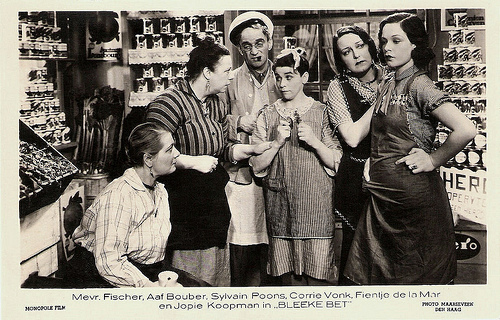
Dutch postcard by Monopole Film, Amsterdam. Photo: Maarseveen, Den Haag. Clara Vischer-Blaaser, Aaf Bouber , Sylvain Poons , Corry Vonk , Fien de la Mar and Jopie Koopman in the Dutch tragicomedy Bleeke Bet (Richard Oswald, Alex Benno, 1936).
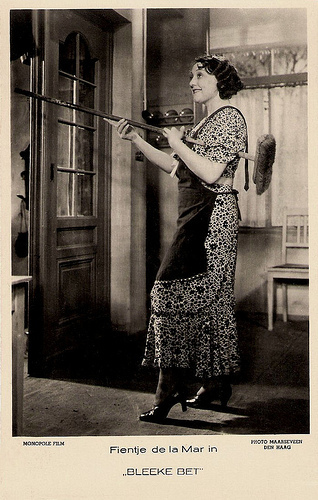
Dutch postcard by M.B. & Z. (M. Bonnist & Zonen, Amsterdam). Photo: Monopole Film / Dick van Maarseveen, Den Haag. Publicity still of Fien(tje) de la Mar in Bleeke Bet (1934).
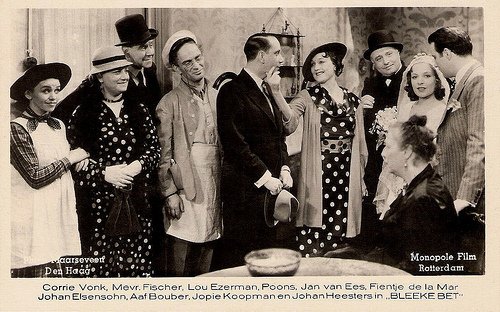
Dutch Postcard. Photo: Dick van Maarseveen. Publicity still for Bleeke Bet (1934).
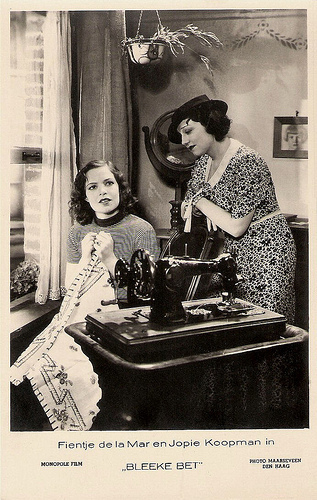
Dutch postcard by Monopole Film, Rotterdam. Photo: Dick van Maarseveen. Publicity still for Bleeke Bet (1934) with Jopie Koopman .
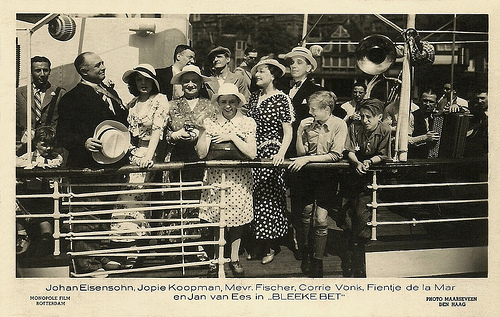
Dutch postcard by Monopole Film, Amsterdam. Photo: Maarseveen, Den Haag. Johan Elsensohn , Jopie Koopman , Clara Vischer-Blaaser, Corry Vonk , Fien de la Mar and Jan van Ees in the Dutch tragicomedy Bleeke Bet (Richard Oswald, Alex Benno, 1934).
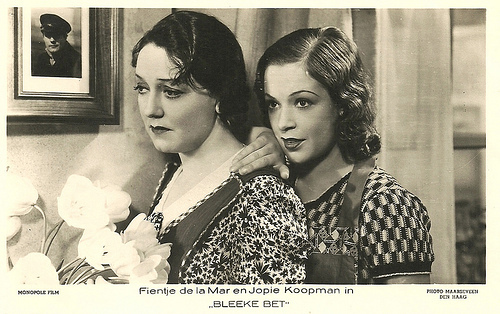
Dutch postcard by Monopole Film. Photo: Maarseveen, Den Haag. Fien(tje) de la Mar and Jopie Koopman in the tragicomedy Bleeke Bet (Alex Benno, Richard Oswald, 1934).
Tragic End
Bleeke Bet proved to be another hit and the following year Fien de la Mar would star in three more films. In the musical Op stap/On the Road (Ernst Winar, 1935) she sang a song, spectacularly accompanied by a dozen pianos.
Her co-star in this film was Frits van Dongen who later would have a Hollywood career as Philip Dorn. They also appeared together in the comedy De Big van het regiment/The Regiment's Mascot (Max Nosseck, 1935).
Her later films include Klokslag twaalf/12 'O Clock (Léo Joannon, 1936) - an alternate language version of Quand minuit sonnera (Léo Joannon, 1936) starring Marie Bell , De spooktrein/The Ghost Train (Carl Lamac, 1939) with Jan Musch , and Ergens in Nederland/Somewhere in the Netherlands (Ludwig Berger, 1940) with Lily Bouwmeester and actor-author Jan de Hartog.
A few weeks after the premiere of the latter film the Second World War started and the film was forbidden by the Nazis. In 1943 Fien refused to work for the Nazi regime and her career halted.
After the war she made a glorious stage come-back and she even had her own theatre for a while. She worked for television, but would not make any more films.
Her life ended tragically in 1965. Fien de la Mar jumped out of the window of her Amsterdam apartment and died a few days later in a hospital. Her legend is kept in an excellent biography by Jenny Pisuisse (1982), a CD and in the stage and television musical Fien (Jan Keja, 1985) with Jasperina de Jong as Fien. And now there is this new documentary by Annette Apon.
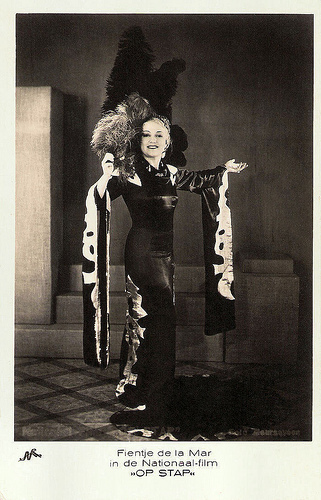
Dutch postcard by M.B. & Z. (M. Bonnist & Zonen, Amsterdam). Photo: Dick van Maarseveen, Den Haag / Nationaal Film. Publicity still of Fien(tje) de la Mar in Op stap/On the Move (Ernst Winar, 1935) .
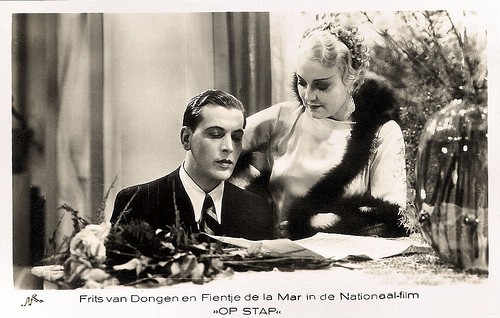
Dutch postcard by M.B. & Z. (M. Bonnist & Zonen, Amsterdam). Photo: Dick van Maarseveen, Den Haag / Nationaal Film. Publicity still for Op stap/On the Move (Ernst Winar, 1935) with Frits van Dongen .
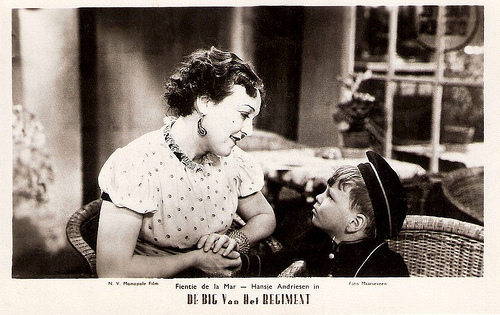
Dutch postcard by NV Monopole Film. Photo: Maarseveen. Fien(tje) de la Mar and Hansje Anderiesen (aka Jansje Andriessen and Hansje Andriesen) in De Big van het regiment (Max Nosseck, 1935).
Fien de la Mar sings Hollandsch Hollywood (1934). Source: Henk Brugge (YouTube).
Clip from Bleeke Bet (1934) with Fien singing Ik wil gelukkig zijn. Source: Brassens66 (YouTube).
Final scene from Op stap/On the Road (1935). Source: CaptainvonTrapp (YouTube).
Trailer for Ik wil gelukkig zijn/One Life is not enough (2016). Source: SNG Film (YouTube).
Sources: Wikipedia, Wim Ibo (Huygens ING) and .

Dutch Postcard by Monopole Film, Rotterdam. Photo: Dick van Maarseveen. Publicity still for Bleeke Bet (1934).

Dutch postcard by M.B. & Z. (M. Bonnist & Zonen, Amsterdam). Photo: Dick van Maarseveen, Den Haag / Monopole Film. Publicity still of Fien(tje) de la Mar in Bleeke Bet (Alex Benno, Richard Oswald, 1934). Collection: Egbert Barten.

Dutch postcard by JosPe. Sent by mail in 1935. Photo: Godfried de Groot .
Capricious
Before WW II, the actress and cabaret artist was known as Fientje de la Mar. She was born in 1898 and named after Josephine de Beauharnais, the first wife of Napoleon Bonaparte.
Her grandfather Charles de la Mar was an admirer of the French emperor and had called his son Napoleon (Nap). Both were famous Dutch actors and Fien started her stage career in 1917 when she was still a school girl.
Immediately Fientje showed talent but also a huge temper. She would become a glamorous and capricious stage star, who loved liquor and would have many lovers.
Her feature film debut was the extremely successful musical De Jantjes/The Tars (Jaap Speyer, 1934), one of the first Dutch sound films. The three title characters were played by Willy Costello , Johan Kaart and Fien's lover Jan van Ees .
Fien's second feature was Bleeke Bet (Richard Oswald, Alex Benno, 1934). In this film she sings her torch song Ik wil gelukkig zijn (I want to be happy).
Bleeke Bet (1934) was based on a popular stage melodrama by Herman Bouber, who also wrote the screenplay. His wife, Aaf Bouber played the title role, a greengrocer of the Jordaan, the old neighbourhood in Amsterdam. Bet wants her daughter Jans ( Jopie Koopman ) to marry a rich man, but Jans loves sailor Ko (the young Johannes Heesters - right on the photo).
The film was a success and would be re-issued in 1941 and 1961. In 1941 the Jewish actors like Sylvain Poons (also on the photo) were cut out of the picture by the Nazi censors. Poons as the ice-cream salesman Sally sings an evergreen in the film, IJslied (Ice-cream Song). The music was composed by emigrant Hans May and the lyrics were written by the later collaborator, Jacques van Tol.

Dutch postcard by Monopole Film, Amsterdam. Photo: Maarseveen, Den Haag. Clara Vischer-Blaaser, Aaf Bouber , Sylvain Poons , Corry Vonk , Fien de la Mar and Jopie Koopman in the Dutch tragicomedy Bleeke Bet (Richard Oswald, Alex Benno, 1936).

Dutch postcard by M.B. & Z. (M. Bonnist & Zonen, Amsterdam). Photo: Monopole Film / Dick van Maarseveen, Den Haag. Publicity still of Fien(tje) de la Mar in Bleeke Bet (1934).

Dutch Postcard. Photo: Dick van Maarseveen. Publicity still for Bleeke Bet (1934).

Dutch postcard by Monopole Film, Rotterdam. Photo: Dick van Maarseveen. Publicity still for Bleeke Bet (1934) with Jopie Koopman .

Dutch postcard by Monopole Film, Amsterdam. Photo: Maarseveen, Den Haag. Johan Elsensohn , Jopie Koopman , Clara Vischer-Blaaser, Corry Vonk , Fien de la Mar and Jan van Ees in the Dutch tragicomedy Bleeke Bet (Richard Oswald, Alex Benno, 1934).

Dutch postcard by Monopole Film. Photo: Maarseveen, Den Haag. Fien(tje) de la Mar and Jopie Koopman in the tragicomedy Bleeke Bet (Alex Benno, Richard Oswald, 1934).
Tragic End
Bleeke Bet proved to be another hit and the following year Fien de la Mar would star in three more films. In the musical Op stap/On the Road (Ernst Winar, 1935) she sang a song, spectacularly accompanied by a dozen pianos.
Her co-star in this film was Frits van Dongen who later would have a Hollywood career as Philip Dorn. They also appeared together in the comedy De Big van het regiment/The Regiment's Mascot (Max Nosseck, 1935).
Her later films include Klokslag twaalf/12 'O Clock (Léo Joannon, 1936) - an alternate language version of Quand minuit sonnera (Léo Joannon, 1936) starring Marie Bell , De spooktrein/The Ghost Train (Carl Lamac, 1939) with Jan Musch , and Ergens in Nederland/Somewhere in the Netherlands (Ludwig Berger, 1940) with Lily Bouwmeester and actor-author Jan de Hartog.
A few weeks after the premiere of the latter film the Second World War started and the film was forbidden by the Nazis. In 1943 Fien refused to work for the Nazi regime and her career halted.
After the war she made a glorious stage come-back and she even had her own theatre for a while. She worked for television, but would not make any more films.
Her life ended tragically in 1965. Fien de la Mar jumped out of the window of her Amsterdam apartment and died a few days later in a hospital. Her legend is kept in an excellent biography by Jenny Pisuisse (1982), a CD and in the stage and television musical Fien (Jan Keja, 1985) with Jasperina de Jong as Fien. And now there is this new documentary by Annette Apon.

Dutch postcard by M.B. & Z. (M. Bonnist & Zonen, Amsterdam). Photo: Dick van Maarseveen, Den Haag / Nationaal Film. Publicity still of Fien(tje) de la Mar in Op stap/On the Move (Ernst Winar, 1935) .

Dutch postcard by M.B. & Z. (M. Bonnist & Zonen, Amsterdam). Photo: Dick van Maarseveen, Den Haag / Nationaal Film. Publicity still for Op stap/On the Move (Ernst Winar, 1935) with Frits van Dongen .

Dutch postcard by NV Monopole Film. Photo: Maarseveen. Fien(tje) de la Mar and Hansje Anderiesen (aka Jansje Andriessen and Hansje Andriesen) in De Big van het regiment (Max Nosseck, 1935).
Fien de la Mar sings Hollandsch Hollywood (1934). Source: Henk Brugge (YouTube).
Clip from Bleeke Bet (1934) with Fien singing Ik wil gelukkig zijn. Source: Brassens66 (YouTube).
Final scene from Op stap/On the Road (1935). Source: CaptainvonTrapp (YouTube).
Trailer for Ik wil gelukkig zijn/One Life is not enough (2016). Source: SNG Film (YouTube).
Sources: Wikipedia, Wim Ibo (Huygens ING) and .
Published on February 02, 2016 22:00
Paul van Yperen's Blog
- Paul van Yperen's profile
- 13 followers
Paul van Yperen isn't a Goodreads Author
(yet),
but they
do have a blog,
so here are some recent posts imported from
their feed.



